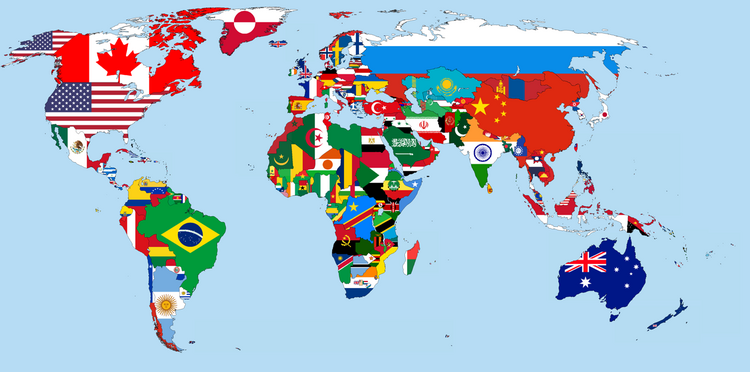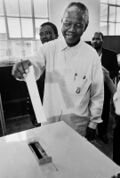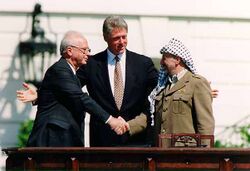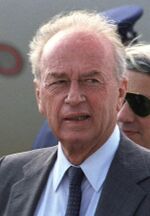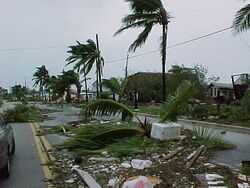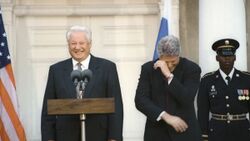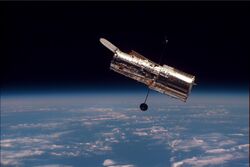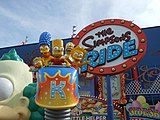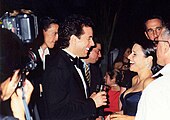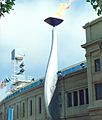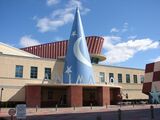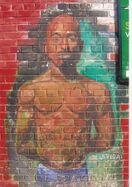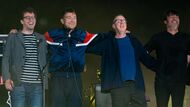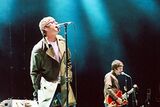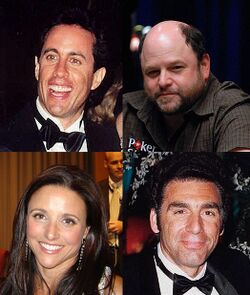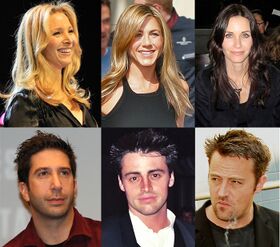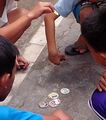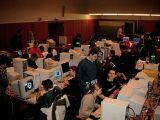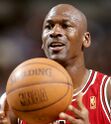History:1990s
Error: No valid link was found at the end of line 3.
The 1990s (pronounced "nineteen-nineties", shortened to "the '90s" and often referred to as simply "the Nineties") was a decade that began on January 1, 1990, and ended on December 31, 1999.
Known as the "post-Cold War decade", the 1990s are culturally imagined by many as the period from the Revolutions of 1989 until the war on terror of the 2000s.[1] The dissolution of the Soviet Union marked the end of Russia's status as a superpower, the establishment of new independent soviet states, the end of a multipolar world, and the rise of anti-Western sentiment. Russia was in economic and political chaos due to neoliberal shock therapy reforms under President Boris Yeltsin until Vladimir Putin came to power in the next decade while China was still recovering from a politically and economically turbulent period under Deng Xiaoping and Jiang Zemin.[2] This allowed for the United States to emerge as the world's sole superpower during this decade after the Cold War, creating a time of relative peace and prosperity for many western countries during this decade.
The decade saw greater attention to multiculturalism as well as the advance of alternative media. In the built environment, the McMansion version of postmodern architecture remained strong throughout the decade. Public education about safe sex curbed the spread of the HIV virus in developed countries. Generation X young people often bonded over musical tastes. Humor in television and film was often marked by ironic self-reference mixed with popular culture references. Alternative music movements like grunge, Eurodance, and hip-hop, became popular with young adults worldwide, aided by the rise in popularity of tiered pricing satellite and cable television, and the internet. New music genres such as drum and bass, post-rock, happy hardcore, denpa, and trance emerged in the 1990s. The computer game industry was also booming as well, most notably the rivalry of music and film markets. Video game popularity exploded due to the development of CD-ROM supported 3DCG on platforms such as Sony PlayStation, Sega Saturn, Nintendo 64, and PCs.
The 1990s saw advances in technology, with the World Wide Web, the evolution of the Pentium microprocessor in accordance with Moore's Law, rechargeable lithium-ion batteries, the first gene therapy trial, and cloning all emerging and being improved upon throughout the decade. The Human Genome Project was formally launched in 1990, building of the Large Hadron Collider commenced in 1998, and Nasdaq (established 1971) became the first stock market in the United States to trade online, using the slogan "the stock market for the next hundred years".[3]
Environmentalism was divided between left-wing green politics, primary industry-sponsored environmentalist front organizations, and a more business-oriented approach to the regulation of carbon footprint of businesses. As more businesses were using information technology, the idea of the paperless office became a realistic long-term goal. The matter of persistent organic pollutants (POPs) was an ongoing concern. In 1995, the Governing Council of the United Nations Environment Programme (UNEP) called for global action to be taken on these "chemical substances that persist in the environment, bio-accumulate through the food web, and pose a risk of causing adverse effects to human health and the environment". The Intergovernmental Forum on Chemical Safety (IFCS) and the International Programme on Chemical Safety (IPCS) then prepared an assessment of the 12 worst chemical substances, leading to the Stockholm Convention on Persistent Organic Pollutants of 2001.
A combination of factors led to a realignment and consolidation of economic and political power across the world, such as the continued mass-mobilization of capital markets through the wave of neoliberalism, globalization, and the end of the Cold War caused by the dissolution of the Soviet Union. Network cultures were enhanced by the widespread proliferation of new media such as the internet, and a new ability to self-publish web pages and make positive connections on a wide variety of professional, political and hobby topics. The new medium was dubbed the information superhighway and soon used by the so-called 'tech savvy'. The digital divide was immediate, with access to the World Wide Web limited to those who could afford it and knew how to operate a home or business computer. The internet also provided a degree of anonymity for individuals skeptical of the government. Online anonymity and the semi-impersonal nature of communication by email and chat rooms led to the words troll and netiquette enter the English language. Online scammers and sex offenders scared many people off the idea of home internet, and traditional mass media continued to perform strongly. However, mainstream internet users were optimistic about its benefits particularly the future of e-commerce. Web portals, (such as AOL, Yahoo!, Yahoo! GeoCities and Lycos), a type of curated bookmark homepage, were as popular as searching via web crawlers. The use of country-specific web portals popularized the phrases netizen and global village. The dot-com bubble of 1997–2000 brought great wealth to some entrepreneurs before its crash of the early-2000s.
Many countries were economically prosperous and spreading globalization during the 1990s. High-income countries experienced steady economic growth throughout the majority of the decade during the Great Moderation (1980s—2000s). Using a mobile phone in a public place was typical conspicuous consumption in the decade. In contrast, the GDP of the states of the former Soviet Union declined, as a result of neoliberal restructuring. International trade increased with the passage of the establishments of the European Union (EU) in 1993, the North American Free Trade Agreement (NAFTA) in 1994, and the World Trade Organization (WTO) in 1995. The Asia-Pacific economies of the Four Asian Tigers (Singapore, Hong Kong, Taiwan, and South Korea), ASEAN, Australia and Japan were hampered by the 1997 Asian financial crisis and the early 1990s recession (including the Lost Decades), resulted the May 1998 riots of Indonesia, the 1996 Australian federal election and the trials on Anwar Ibrahim, marked the dawn of the 32-year Suharto dictatorship, the Hawke–Keating government and Mahathirism in Malaysia.
Major wars that began in the 1990s include the First and Second Congo Wars, the Rwandan Civil War and genocide, the Burundian Civil War, the Somali Civil War, the Algerian Civil War, and the Sierra Leone Civil War in Africa; the Yugoslav Wars in Southeast Europe; the First and Second Chechen Wars, and the Tajikistani Civil War in the former Soviet Union; and the Gulf War and 1991 Iraqi uprisings in the Middle East. The Afghanistan conflict (1978–present) and Colombian conflict continued throughout the decade. The Oslo Accords at first seemed to herald an end to the Israeli-Palestinian conflict, but these hopes were in vain. However, in Northern Ireland, The Troubles came to a standstill in 1998 with the Good Friday Agreement, ending 30 years of violence.[4]
During this decade, the world population grew from 5.3 to 6.1 billion people. There were approximately 1.35 billion births and 525 million deaths.[5]
Politics and wars
International wars
- The Congo Wars began in the 1990s.[6]
- The First Congo War (October 24, 1996 – May 16, 1997) resulted in the overthrow of dictator Mobutu Sese Seko, his 32 rule of Zaire, which was then renamed the Democratic Republic of the Congo.
- The Second Congo War (August 1998 – July 2003) started in Central Africa and involved multiple nearby nations.
- The Gulf War (August 2, 1990 – February 28, 1991).
- Iraq was left in severe debt after the Iran–Iraq War in the 1980s. President Saddam Hussein accused Kuwait of flooding the oil market, therefore driving down prices. As a result, Iraqi forces invaded and conquered Kuwait.
- The UN (United Nations ) immediately condemned the action and a coalition force led by the United States was sent to the Persian Gulf. Aerial bombing of Iraq began in January 1991, and one month later, the UN forces drove the Iraqi army from Kuwait in four days.
- Two wars were fought in the region of Chechnya:
- The First Chechen War (1994–1996) was a conflict between the Russia and the Chechen Republic of Ichkeria. After the initial campaign of 1994–1995, culminating in the devastating Battle of Grozny, Russian federal forces attempted to seize control of the mountainous area of Chechnya. Despite Russia's overwhelming manpower, weaponry, and air support, they were set back by Chechen guerrillas and raids on the flatlands. The resulting widespread demoralization of Russian federal forces, and the universal[citation needed] opposition of the Russian public to the conflict, led Boris Yeltsin's government to declare a ceasefire in 1996 and sign a peace treaty a year later.
- The Second Chechen War (1999 – 2009) was started by the Russian Federation in response to the 1999 invasion of Dagestan and the Russian apartment bombings, which were blamed on the Chechens. In this military campaign, Russian forces largely recaptured the separatist region of Chechnya[citation needed] and the outcome of the First Chechen War – in which the region gained de facto independence as the Chechen Republic of Ichkeria – was essentially reversed.
- The Eritrean–Ethiopian War (1998–2000) was commenced by the invasion of Ethiopia by Eritrea due to a territorial dispute.[7] The conflict resulted in tens of thousands of deaths on both sides[8] and a peace agreement in December 2000.[9]
- The Kargil War (1999) began in May when Pakistan covertly sent troops to occupy strategic peaks in Kashmir. A month later, the Kargil War with India resulted in a political fiasco for Pakistani Prime Minister Nawaz Sharif, followed by a Pakistani military withdrawal to the Line of Control. The incident led to a Pakistani military coup in October, in which Sharif was ousted by Army Chief Pervez Musharraf. This conflict remains the only war fought between the two declared nuclear powers.
- The Yugoslav Wars (1991–1995) followed the breakup of Yugoslavia, beginning on June 25, 1991, after the republics of Croatia and Slovenia declared independence from Yugoslavia. These wars were notorious for war crimes and human rights violations, including ethnic cleansing and genocide, with the overwhelming majority of casualties being Muslim Bosniaks.
- The Ten-Day War (1991) was a brief military conflict between Slovenian TO (Slovenian Territorial Defence) and the Yugoslav People's Army ("JNA") following Slovenia's declaration of independence.
- The Croatian War of Independence (1991–1995) was fought in modern-day Croatia between the Croatian government (having declared independence from the Socialist Federal Republic of Yugoslavia) and both the Yugoslav People's Army ("JNA") and Serb forces, who established the self-proclaimed Republic of Serbian Krajina ("RSK") within Croatia.
- The Bosnian War (1992–1995) involved several ethnically-defined factions within Bosnia and Herzegovina: Bosniaks, Serbs, and Croats, as well as a smaller Bosniak faction led by Fikret Abdić. The Siege of Sarajevo (1992–1995) marked the most violent urban warfare in Europe since World War II at that time, as Serb forces bombarded and attacked Bosnian-controlled and populated areas of the city. War crimes occurred, including ethnic cleansing and the destruction of civilian property.
- The final fighting in the Croatian and Bosnian wars ended in 1995 with the success of Croatian military offensives against Serb forces. This led to the mass exodus of Serbs from Croatia, Serb losses to Croat and Bosniak forces, and the signing of the Dayton Agreement, which internally partitioned Bosnia and Herzegovina into a Republika Srpska and a Bosniak-Croat Federation.
- The Kosovo War (1998–1999) was a war between Albanian separatists and Yugoslav military and Serb paramilitary forces in Kosovo. That conflict began in 1996 and escalated in 1998, with increasing reports of atrocities.
- In 1999, the NATO, led by the United States, launched air attacks against Yugoslavia (then composed of only Serbia and Montenegro) to pressure the Yugoslav government to end its military operations against Albanian separatists in Kosovo. The intervention lacked UN approval yet was justified by NATO based on accusations of war crimes committed by Yugoslav military forces working alongside nationalist Serb paramilitary groups. Finally, after months of bombing, Yugoslavia conceded to NATO's demands, and NATO forces (later UN peacekeeping forces) occupied Kosovo.
- The South African Border War (1990) was a border war between Zambia, Angola, and Namibia that began in 1966 and ended in 1990.
Civil wars and guerrilla wars
- The First Liberian Civil War occurred from 1989 until 1997 and led to the death of around 200,000 people.
- The Ethiopian Civil War (1991) was an internal conflict that had been raging for over twenty years. Its end coincided with the establishment of a coalition government of various factions.
- The Algerian Civil War (1991–2002) was caused by a group of high-ranking army officers canceling the first multi-party elections in Algeria.[10]
- The Somali Civil War (1991–present) included the Battle of Mogadishu.
- The Rwandan genocide (1994) occurred from April 6 to mid-July 1994 when hundreds of thousands of Rwanda's Tutsis and Hutu political moderates were killed by the Hutu-dominated government under the Hutu Power ideology. For approximately 100 days between 500,000[11] and 1,000,000[12] people were killed. The United Nations and major states came under criticism for failing to stop the genocide.
- 1993 Russian constitutional crisis resulted from a severe political deadlock between Russian President Boris Yeltsin and the Supreme Soviet (Russia's parliament at this time) resulting in Yeltsin ordering the controversial shelling of the Russian parliament building by tanks.
- The Tajikistani Civil War (1992–1997) occurred when the Tajikistan government was pitted against the United Tajik Opposition, resulting in the death of between 50,000 and 100,000 people.
- The Zapatista uprising (1994) occurred when a large number of the Zapatista indigenous people of Mexico formed the Zapatista Army of National Liberation and began an armed conflict with the Mexican government to protest against NAFTA. The uprising lasted 12 days, bringing worldwide attention to the Zapatistas, and continued through the rest of the 1990s.
- The Islamic Emirate of Afghanistan (1996–2001) was formed at the end of the Afghan Civil War, when the Taliban seized control of Afghanistan in 1996. They ruled during the later Afghan Civil War until their ousting 2001.
- The Troubles in Northern Ireland (1998) involved 30 years of conflict that ended on 10 April 1998, when the Good Friday Agreement was signed.
- 1999 East Timorese crisis.
Coups
Terrorist attacks
- The 1993 World Trade Center bombing in the United States (1993) led to broader public awareness in the U.S. of domestic terrorism and international terrorism as a potential threat.
- Markale market massacres in Bosnia and Herzegovina (1994) – soldiers of the Army of Republika Srpska deliberately targeted Bosniak (then known as "Bosnian Muslims") civilians.
- AMIA bombing (1994) – on 18 July 1994, an unknown terrorist targeting Argentina's Jewish community planted a car bomb in the Asociación Mutual Israelita Argentina headquarters in Buenos Aires, killing 85 people and injuring hundreds, making it the first ethnically targeted bombing and deadliest bombing in Argentine history.
- Srebrenica genocide in Bosnia and Herzegovina (1995) – soldiers of the Army of Republika Srpska and members of Serbia's Scorpions paramilitary group committed mass murder of Bosniak civilians.[citation needed]
- Oklahoma City bombing (1995) in the United States – the bombing of a federal building in Oklahoma City, Oklahoma killed 168 people, becoming the deadliest terrorist attack in the United States at that time. Suspect Timothy McVeigh claimed he bombed the building in retaliation for the 1992 Ruby Ridge standoff and the Waco siege a year later.[13]
- The 1996 Manchester bombing (1996) – on 15 June 1996, the IRA set off a bomb in Manchester, England. The bomb, placed in a van on Corporation Street in the city center, targeted the city's infrastructure and economy and caused widespread damage, estimated by insurers at £700 million (£1 billion (As of 2011)). Two hundred and twelve people were injured, but there were no fatalities.
- The 1998 United States embassy bombings – Al-Qaeda militants carried out bomb attacks on United States embassies in Kenya and Tanzania. In retaliation, U.S. naval military forces launched cruise missile attacks against Al-Qaeda bases in Afghanistan.
- The Omagh bombing in Northern Ireland (1998) – a bombing in Omagh, County Tyrone, that killed 29 civilians and injured hundreds more.
- LAX bombing plot (1999) – Ahmed Ressam, an Islamist militant associated with Al-Qaeda, was arrested when attempting to cross from Canada into the United States at the Canada-U.S. border on 14 December 1999. It was later discovered that he intended to bomb Los Angeles International Airport (LAX) during millennium celebrations. This was the first major attempted terrorist attack by Al-Qaeda on United States soil since the 1993 World Trade Center bombing and marked the beginning of a series of attempted terrorist attacks by Al-Qaeda against the United States that would continue into the 21st century.
Decolonization and independence
- Independence of Namibia (1990) – the Republic of Namibia gained independence from South Africa on 21 March 1990. Walvis Bay, initially retained by South Africa, joined Namibia in 1994.
- Breakup of Yugoslavia (1991–1992) – the republics of Croatia, Slovenia, Bosnia and Herzegovina, and Macedonia declared independence from Yugoslavia.
- Independence of Eritrea (1993) – Eritrea gained independence from Ethiopia.
- Dissolution of Czechoslovakia (1993) – the Slovak Republic adopts the Declaration of Independence from the Czech and Slovak Federative Republic (Czechoslovakia).
- Independence of Palau (1994) – Palau gained independence from the United Nations Trusteeship Council.
- Handover of Hong Kong (1997) – The United Kingdom handed sovereignty of Hong Kong (then British Hong Kong) to the People's Republic of China on 1 July 1997.
- Independence of East Timorese (1999) – East Timor broke away from Indonesian occupation, only a year after the fall of Suharto from power, ending a 24-year guerrilla war and genocide with more than 200,000 casualties. The UN deployed a peacekeeping force spearheaded by Australia's armed forces. The United States deployed police officers to serve with the Interpol element to help train and equip an East Timorese police force.
- Handover of Macau (1999) – Portugal handed sovereignty of Macau (Portuguese Macau) to the People's Republic of China on 20 December 1999.
- Dissolution of the Soviet Union (1991) – multiple Soviet Socialist Republics (SSRs) declared independence from the Union of Soviet Socialist Republics .
- Armenia – the Armenian SSR became the Republic of Armenia following the Declaration of Independence of Armenia.
- Azerbaijan – the Azerbaijan SSR became the Republic of Azerbaijan.
- Belarus – the Byelorussian SSR became the Republic of Belarus following its Declaration of State Sovereignty.
- Estonia – Estonian SSR became the Republic of Estonia.
- Georgia – The Georgian SSR became the Republic of Georgia.
- Kazakhstan – the Kazakh SSR became the Republic of Kazakhstan.
- Kyrgyzstan – the Kirghiz SSR became the Republic of Kyrgyzstan.
- Latvia – the Latvian SSR became the Republic of Latvia.
- Lithuania – the Lithuanian SSR became the Republic of Lithuania
- Moldova – the Moldavian SSR became the Republic of Moldova.
- Tajikistan – the Tajik SSR became the Republic of Tajikistan.
- Turkmenistan – the Turkmen SSR became the Republic of Turkmenistan.
- Ukraine – the Ukrainian SSR became the Republic of Ukraine
- Uzbekistan – the Uzbek SSR became the Republic of Uzbekistan.
Political trends
- The 1990s saw an increased spread of capitalism and third way policies.[14] The former countries of the Warsaw Pact moved from single-party socialist states to multi-party states with private sector economies.[14] The same wave of political liberalization occurred in the capitalist and newly industrialized countries (including First and Third World countries), such as Argentina , Brazil , Chile , India , Indonesia, Malaysia, Mexico, the Philippines , South Africa , South Korea , Taiwan, and Thailand. Market reforms made incredible changes to the economies of Second World socialist countries such as China and Vietnam.
- Ethnic tensions and violence in former Yugoslavia during the 1990s created a greater sense of ethnic identity among nations in newly independent countries and a marked increase in the popularity of nationalism.
Prominent political events
Africa
- African National Congress leader Nelson Mandela was released from prison on 11 February 1990, after thirty years of imprisonment for opposing apartheid and white-minority rule in South Africa. Apartheid ended in South Africa in 1994.[15]
- Nelson Mandela was elected President of South Africa in 1994, becoming the first democratically elected president in South African history, and ending a long legacy of apartheid white rule in the country.[15]
Americas
File:Response to the Lewinsky Allegations (January 26, 1998) Bill Clinton.ogv
- The establishment of the North American Free Trade Agreement (NAFTA) on January 1, 1994, created a North American free-trade zone consisting of Canada, Mexico, and the United States.
- Canadian politics was radically altered in the 1993 federal election with the collapse of the Progressive Conservative Party of Canada. A major political party in Canada since 1867, the party went from controlling the government to being left with only two seats. The New Democratic Party collapsed as well, with their sets declining from 44 to 9. The Liberal Party of Canada was the only genuinely 'national' political party left standing. Regionally-based parties, such as the Quebec-based Bloc Québécois and the almost entirely Western Canada-based Reform Party of Canada, rose from political insignificance to being major political parties.
- After the collapse of the Meech Lake constitutional accord in 1990, the province of Quebec in Canada experienced a rekindled wave of separatism by Francophone Québécois nationalists, who sought for Quebec to become an independent country and forced a referendum on the question of independence in 1995.
- The 1995 Quebec referendum on sovereignty was held in the predominantly francophone province of Quebec in Canada, a majority Anglophone country. If accepted, Quebec would have become an independent country with an economic association with Canada. Quebec's voters narrowly rejected the proposal.
- Jean-Bertrand Aristide, a former Haitian priest, became the first democratically elected President of Haiti in 1990. A proponent of liberation theology, Aristide was appointed to a Roman Catholic parish in Port-au-Prince in 1982 after completing his studies to become a priest of the Salesian order. Aristide was later forced into exile in the Central African Republic and South Africa and returned to Haiti after several years.
- Ernesto Zedillo was elected President of Mexico in the 1994 presidential election, making him the last of an uninterrupted 72-year-long succession of Mexican presidents from the dominant Institutional Revolutionary Party (PRI). The original PRI candidate, Luis Donaldo Colosio Murrieta, was assassinated several months prior.
- Due to internal conflict and an economic crisis, Alberto Fujimori rose to power in Peru and remained in office for eleven years. His administration was marked by economic development but also by numerous human rights violations (La Cantuta massacre, Barrios Altos massacre) and a rampant corruption network set up by Vladimiro Montesinos.
- The sluggish Latin American economies of Argentina , Brazil , Chile , and Mexico, by a new emphasis on free markets for all their citizens after the debt crisis of the 1980s. Following democratic reforms and neoliberal policies were implemented by President Carlos Saúl Menem (Argentina), President Eduardo Frei Ruiz-Tagle (Chile), President Ernesto Zedillo (Mexico), and President Fernando Henrique Cardoso (Brazil), in their best shape by the late 1990s.
- United States President Bill Clinton was a dominant political figure in international affairs during the 1990s, known primarily for his attempts to negotiate peace in the Middle East and end the ongoing wars occurring in the former Yugoslavia, his promotion of international action to decrease human-created climate change, and his endorsement of advancing free trade in the Americas.
- After a failed coup attempt in 1992, Hugo Chávez, politician and former member of the Venezuelan military, is elected President of Venezuela in 1998.
- Lewinsky scandal – US president Bill Clinton was caught in a media-frenzied scandal involving inappropriate relations with White House intern Monica Lewinsky, which was first announced on January 21, 1998. After the United States House of Representatives impeached Bill Clinton on December 19, 1998, for perjury under oath, and following an investigation by federal prosecutor Kenneth Starr, the Senate acquitted Clinton of all charges on February 12, 1999. He served out the remainder of his second term.
- California voters passed Proposition 215 in 1996, which legalized cannabis for medicinal purposes.
Asia
- In 1990, the Lebanese Civil War came to a close and a return to political normalcy in Lebanon began. With peace among all factions in Lebanon, the rebuilding of the country and its capital, Beirut, began.
- 1990 Nepalese revolution, a multiparty movement against the one-party Panchayat rule in Nepal. It led to the end of absolute monarchy in Nepal and the restoration of democracy.
- Israeli Prime Minister Yitzhak Rabin and Palestinian Prime Minister Yasser Arafat agree to the Israeli–Palestinian peace process at the culmination of the Oslo Accords, negotiated by the United States President, Bill Clinton, on 13 September 1993.
- By signing the Oslo accords, the Palestine Liberation Organization recognized Israel's right to exist. At the same time, Israel permitted the creation of an autonomous Palestinian National Authority consisting of the Gaza Strip and West Bank, which was implemented in 1994.
- Israeli military forces withdrew from these Palestinian territories in compliance with the accord, which marked the end of the First Intifada (a period of violence between Palestinian Arab militants and Israeli armed forces from 1987 to 1993).
- The Palestinian National Authority was created in 1994 following the Oslo Accords, giving Palestinian Arab people official autonomy over the Gaza Strip and West Bank, though not official independence from Israel.
- On 4 November 1995, Israeli Prime Minister Yitzhak Rabin was assassinated by a right-wing extremist who opposed the signing of the Oslo Accords.
- North Yemen and South Yemen merged to form Yemen in 1991.
- Lee Kuan Yew resigned as the Prime Minister of Singapore on 28 November 1990, a position he had held since 1959, to Goh Chok Tong. Lee remained in the cabinet as Senior Minister.
- In July 1994, North Korean leader Kim Il Sung died, having ruled the country since its founding in 1948. His son Kim Jong Il, who succeeded him, took over a nation on the brink of complete economic collapse. Famine had caused a significant number of deaths in the late 1990s, and North Korea gained a reputation for being an important hub of money laundering, counterfeiting, and weapons proliferation. The country's ability to produce and sell nuclear weapons became a prominent concern in the international community.
- In 1990, Aung San Suu Kyi's National League for Democracy in Burma won a majority of seats in the first free election conducted in 30 years. But the SPDC refused to relinquish power, beginning a peaceful[citation needed] struggle that began in the 1990s and continued for several decades, primarily fueled by Aung San Suu Kyi and her supporters to demand the end of military rule.
- Indonesian President Suharto resigned after ruling the country for 32 years (1966–1998), following the riots on several cities in Indonesia. His resignation marked the beginning of the Reform era.
- In India, the former prime minister Rajiv Gandhi was assassinated on 21 May 1991 by the Tamil Tigers, beginning a period of economic liberalization led by new Prime Minister P. V. Narasimha Rao.
- After democratic reforms and steady economic growth in the four Asia-Pacific MNNAs by the United States and Canada, after the Revolutions of 1989.
- In the Philippines , following the People Power Revolution of 1986 under the Corazon Aquino presidency until 1992, democratic reforms and economic policies implemented by two Presidents were elected by Fidel V. Ramos in 1992, and Joseph Estrada in 1998.
- South Korea and Taiwan became developed countries, and two of the Four Asian Tigers in the 1990s. Following democratic reforms in 1988, neoliberal policies were implemented by President Kim Young-sam (South Korea) and President Lee Teng-hui (Taiwan), both who led their countries during the 1997 Asian financial crisis.
- Japan saw eight different prime ministers serve during the 1990s in what was at first called the "Lost Decade" but later became referred to as the "Lost Decades of the Heisei Era". These included Morihiro Hosokawa, who won the 1993 Japanese general election and formed an opposition coalition until 1996.
Europe
- The improvement in relations between NATO countries and the former members of the Warsaw Pact led to the end of the Cold War, both in Europe and other parts of the world.
- German reunification – on 3 October 1990, East and West Germany reunified as a result of the collapse of the Soviet Union and the fall of the Berlin Wall. After reintegrating their economic structure and provincial governments, Germany focused on the modernization of the formerly communist East. People brought up in socialist East Germany became integrated with those living in capitalist West Germany.
- Margaret Thatcher, who had been the United Kingdom's Prime Minister since 1979, resigned as Prime Minister on 22 November 1990 after being challenged for leadership of the Conservative Party by Michael Heseltine. This was because of widespread opposition to the introduction of the controversial Community Charge, and the fact that her key allies such as Nigel Lawson and Geoffrey Howe resigned over the deeply sensitive issues of the Maastricht Treaty and Margaret Thatcher's resistance to Britain joining the European Exchange Rate Mechanism. Less than two years later, on the infamous Black Wednesday of September 1992, the pound sterling crashed out of the system after the pound fell below the agreed exchange rate with the Deutsche Mark.
- John Major replaced Margaret Thatcher as Prime Minister in 1990.
- The Perestroika (restructuring) of the Soviet Union destabilized, leading to nationalist and separatist demagogues gaining popularity. Boris Yeltsin, then chairman of the Supreme Soviet of Russia, resigned from the Communist Party and became the opposition leader against Mikhail Gorbachev. The Communist Party lost its status as the governing force of the country and was banned after a coup attempt by communist hardliners attempted to revert the effects of Gorbachev's policies. Yeltsin's counter-revolution was victorious, and on 25 December 1991, Gorbachev resigned from the presidency, which led to the dissolution of the Soviet Union. Yeltsin became president of the Soviet Union's successor, the Russian Federation, and presided over a period of political unrest, economic crisis, and social anarchy. On 31 December 1999, Yeltsin resigned, leaving Vladimir Putin as acting president.
- The European Union was formed in 1992 under the Maastricht Treaty.
- The Downing Street Declaration, signed on 15 December 1993 by the Prime Minister of the United Kingdom, John Major, and the Taoiseach of Ireland, Albert Reynolds at the British Prime Minister's office in 10 Downing Street, affirmed that (1) the right of the people of Ireland to self-determination, and (2) that Northern Ireland would be transferred to the Republic of Ireland from the United Kingdom only if a majority of its population was in favour of such a move. It included, as part of the perspective of the so-called "Irish dimension," the principle of consent that the people of the island of Ireland had the exclusive right to solve the issues between North and South by mutual consent.[16][17] The latter statement, which later would become one of the points of the Good Friday Agreement,[18] was key to producing a positive change of attitude by the Republicans towards a negotiated settlement. The joint declaration also pledged the governments to seek a peaceful constitutional settlement and promised that parties linked with paramilitaries (such as Sinn Féin) could take part in the talks so long as they abandoned violence.[19]
- The IRA agreed to a truce in 1994. This marked the beginning of the end of 25 years of violence between the IRA and the United Kingdom and the start of political negotiations.
- Tony Blair became Prime Minister in 1997 following a general election.
- The Belfast Agreement (a.k.a. the Good Friday Agreement) was signed by the U.K. and Irish politicians on 10 April 1998, declaring a joint commitment to a peaceful resolution of the territorial dispute between Ireland and the United Kingdom over Northern Ireland. The 1998 Northern Ireland Good Friday Agreement referendum was held on 22 May 1998, with majority approval.[20]
- The National Assembly for Wales was established following the 1997 Welsh devolution referendum, in which a majority of voters approved the creation of the National Assembly for Wales.[21]
- In September 1997, the 1997 Scottish devolution referendum was put to the Scottish electorate and secured a majority in favor of the establishment of a new Scottish Parliament.[22][23]
Assassinations and attempts
Prominent assassinations, targeted killings, and assassination attempts include:

| Date | Description |
|---|---|
| September 9, 1990 | Samuel Doe, 21st President of Liberia, was captured by rebels, tortured and murdered. His torture was controversially videotaped and seen on news reports around the world.[24] |
| May 21, 1991 | Rajiv Gandhi, former Prime Minister of India , is assassinated in Sriperumbudur.[25] |
| August 7, 1991 | Shapour Bakhtiar, former Prime Minister of Iran, is assassinated by Islamic Republic agents.[26] |
| June 29, 1992 | Mohamed Boudiaf, President of Algeria, is assassinated by a bodyguard.[27] |
| April 13, 1993 | George H. W. Bush, former President of the United States , is alleged to be the target of an assassination by Iraq per a report from the Kuwaiti government during a visit to the country.[28] |
| May 1, 1993 | Ranasinghe Premadasa, 3rd President of Sri Lanka, is killed by a suicide bombing.[29] |
| October 21, 1993 | Melchior Ndadaye, 4th President of Burundi, is killed during an attempted military coup.[30] |
| December 2, 1993 | Pablo Escobar, leader of the Medellín drug cartel, is killed by special operations units of the National Police of Colombia.[31] |
| March 23, 1994 | Luis Donaldo Colosio Murrieta, the Institutional Revolutionary Party candidate in the 1994 Mexican general election, was assassinated at a campaign rally in Tijuana. |
| April 6, 1994 | Juvénal Habyarimana, 2nd President of Rwanda, and Cyprien Ntaryamira, 5th President of Burundi, are both killed when their jet is shot down in what is considered the prelude to the Rwandan genocide and the First Congo War.[32] |
| November 4, 1995 | Yitzhak Rabin, 5th Prime Minister of Israel, is assassinated at a rally in Tel Aviv by a radical ultranationalist who opposed the Oslo Accords.[33] |
| April 21, 1996 | Dzhokhar Dudayev, 1st President of Chechnya, is killed by two laser-guided missiles after his location was detected by a Russian reconnaissance aircraft.[34] |
| October 2, 1996 | Andrey Lukanov, former Prime Minister of Bulgaria, is shot outside his apartment in Sofia.[35] |
| March 23, 1999 | Luis María Argaña, Vice President of Paraguay, is assassinated by gunmen outside his home.[36] |
| April 9, 1999 | Ibrahim Baré Maïnassara, 5th President of Niger, is assassinated by members of his protective staff in Niamey.[37] |
Disasters
Natural disasters
The 1990s saw a trend in frequent and more devastating natural disasters, breaking many previous records. Although the 1990s was designated by the United Nations as an International Decade for Natural Disaster Reduction as part of its program to prevent losses due to disasters, disasters would go on to cause a record-breaking US$608 billion worth of damage—more than the past four decades combined.[38]
- The most prominent natural disasters of the decade include: Hurricane Andrew striking South Florida in August 1992, the crippling super storm of March 1993 along the Eastern Seaboard, the devastating 1994 Northridge earthquake in Los Angeles, the Great Hanshin earthquake in Kobe, Japan in January 1995, the Blizzard of 1996 in the eastern United States, the US drought of 1999, the deadly Hurricane Mitch which struck Central America in October 1998, the destructive Oklahoma tornado outbreak in May 1999, the August 1999 İzmit earthquake in Turkey, and the September 1999 Chi-Chi earthquake in Taiwan.
- A magnitude 7.8 earthquake hit the Philippines on 16 July 1990 and killed around 1000 people in Baguio.
- After 600 years of inactivity, Mount Pinatubo in the Philippines erupted and devastated Zambales and Pampanga in June 1991.
- July 1995 – Midwestern United States heat wave – An unprecedented heat wave strikes the Midwestern United States for most of the month. Temperatures peak at 106 °F (41 °C), and remain above 94 °F (34 °C) in the afternoon for 5 straight days. At least 739 people died in Chicago alone.
- Hurricane Georges made landfall in at least seven different countries (Antigua and Barbuda, St. Kitts and Nevis, Haiti, the Dominican Republic, Cuba, the United States and Puerto Rico, a Commonwealth of the United States) – more than any other hurricane since Hurricane Inez of the 1966 season. The total estimated costs were $60 billion (about $110 billion in 2022).
- September 1996 – Hurricane Fran made landfall in North Carolina, causing significant damage throughout the entire state.
- Hurricane Iniki hit the island of Kauai in the Hawaiian Islands on 11 September 1992, making it one of the costliest hurricanes on record in the eastern Pacific.
- A flood hits the Red River Valley in 1997 becoming the most severe flood since 1826.
- In December 1999, torrential rains and flash floods killed tens of thousands of Venezuelans living in the state of Vargas in a natural disaster known as the Vargas tragedy.
Non-natural disasters
- Gulf War oil spill: Resulting from actions taken during the Gulf War in 1991 by the Iraq military, the oil spill caused considerable damage to wildlife in the Persian Gulf, especially in areas surrounding Kuwait and Iraq.
- July 11, 1991: A Nationair Douglas DC-8, chartered by Nigeria Airways, caught fire and crashed in Jeddah, Saudi Arabia, killing 261 people.
- December 15, 1991: The Egyptian ferry Salem Express sinks in the Red Sea, killing more than 450 people.
- October 4, 1992: El Al Flight 1862, a Boeing 747 cargo airplane heading to Tel Aviv, suffered physical engine separation of both right-wing engines (#3 and #4) just after taking off from Schiphol and crashed into an apartment building in the Bijlmer neighbourhood of Amsterdam while attempting to return to the airport. A total of 43 people were killed, including the plane's crew of three and a "non-revenue passenger." Several others were injured.
- July 26, 1993: Asiana Airlines Flight 733 crashed into Mt. Ungeo in Haenam, South Korea, killing 68 people.
- April 26, 1994: China Airlines Flight 140, an Airbus A300, crashed just as it was about to land at Nagoya Airfield, Japan, killing 264 and leaving only seven survivors.
- September 8, 1994: USAir Flight 427 crashed near Pittsburgh, Pennsylvania, killing 132 people.
- September 28, 1994: The car ferry MS Estonia sinks in the Baltic Sea, killing 852 people.
- June 29, 1995: The Sampoong Department Store collapses in Seoul, South Korea, killing 502 people.
- December 20, 1995: American Airlines Flight 965, a Boeing 757, hit a mountain in Colombia at night, killing 159 people.
- July 17, 1996: Trans World Airlines Flight 800, a Boeing 747-131 exploded and crashed into the Atlantic Ocean near East Moriches, New York, killing 230.
- November 12, 1996: A Saudia Boeing 747 and a Kazakhstan Airlines Ilyushin Il-76 collided over the town of Charkhi Dadri, outside New Delhi, India, killing 349.
- August 6, 1997: Korean Air Flight 801, a Boeing 747-300, crashed into a hill on the island of Guam, killing 228 people.
- September 26, 1997: Garuda Indonesia Flight 152 crashed in bad weather, killing 234.
- September 2, 1998: Swissair Flight 111, a McDonnell Douglas MD-11, crashed into the Atlantic Ocean off Nova Scotia near the towns of Peggy's Cove and Bayswater, killing 229.
- October 31, 1999: EgyptAir Flight 990, a Boeing 767, crashed off the coast of Nantucket, Massachusetts, killing 217.
Economics
Many countries, institutions, companies, and organizations were prosperous during the 1990s. High-income countries such as the United States, Canada, Australia, New Zealand, Japan, Singapore, Hong Kong, Taiwan, South Korea, and Western Europe experienced steady economic growth for much of the decade during the Great Moderation. However, in the former Soviet Union, GDP decreased as their economies restructured to produce goods they needed, and some capital flight occurred.
- In 1993, the General Agreement on Tariffs and Trade (GATT) was updated to include the creation of the World Trade Organization, with the 76 existing GATT members and European Communities becoming the founding members of the World Trade Organization on 1 January 1995. Opposition by anti-globalization activists showed up in nearly every GATT summit, like the demonstrations in Seattle in December 1999.
- The anti-globalization protests in the World Trade Organization Ministerial Conference of 1999 in Seattle began on 30 November 1999. This marked the beginning of a steady increase in anti-globalization protests in the first decade of the 21st century and increasing hostility to neoliberalism.
- U.S. inflation moderated, beginning in 1990 at 5.39%, falling to a low of 1.55% in 1998 and rising slightly to 2.19% in 1999.[39]
- The G20 or Group of Twenty formed on the 26 September 1999.
North America
- The decade is seen as a time of great prosperity in the United States and Canada, largely because of the unexpected advent of the Internet and the explosion of technology industries. The U.S. and Canadian economies experienced their longest period of peacetime economic expansion, beginning in 1991. Personal incomes doubled from the recession in 1990, and there was higher productivity overall. The New York Stock Exchange stayed over the 10,500 mark from 1999 to 2001.
- After the 1992 boom of the US stock market, Alan Greenspan coined the phrase "irrational exuberance", a reference to the overenthusiam of investors that typified the trading of this period, and warned of overvaluation of assets and the stock market generally.
- The North American Free Trade Agreement (NAFTA), which phases out the trade barriers between the United States, Mexico, and Canada, was signed into law by President Bill Clinton.
Asia
- In the China , the government announced the major privatization of state-owned industries in September 1997. China entered the 1990s in a turbulent period due to the aftermath of both the Tiananmen Square Massacre and hardline politicians' efforts to rein in private enterprise and attempt to revive old-fashioned propaganda campaigns. Relations with the United States deteriorated sharply, and the Chinese leadership was further embarrassed by the disintegration of communism in Europe. In 1992 Deng Xiaoping travelled to southern China in his last major public appearance to revitalize faith in market economics and stop the country's slide back into Maoism. Afterward, China recovered and would experience explosive economic growth during the rest of the decade. Despite this, dissent continued to be suppressed, and Communist Party General Secretary Jiang Zemin launched a brutal crackdown against the Falun Gong religious sect in 1999. Deng Xiaoping died in 1997 at the age of 93. Relations with the US deteriorated again in 1999 after the bombing of the Chinese embassy during the bombing of Serbia by NATO forces, which caused three deaths, and allegations of Chinese espionage at the Los Alamos Nuclear Facility.
- Financial crisis hits East and Southeast Asian countries between 1997 and 1998 after a long period of phenomenal economic development, which continues into 1999. This crisis begins to be felt by the end of the decade.
- In Japan , after three decades of economic growth put them in second place in the world's economies, the county experienced an economic downturn after 1993. The recession went on into the early first decade of the 21st century, ending the seemingly unlimited prosperity that the country had previously enjoyed.
- Less affluent nations such as India , Malaysia, and Vietnam also saw tremendous improvements in economic prosperity and quality of life during the 1990s. Restructuring following the end of the Cold War was beginning. However, there was also the continuation of terrorism in Third World regions that were once the "frontlines" for American and Soviet foreign politics, particularly in Asia.
Europe
- By 1990, Soviet leader Mikhail Gorbachev's reforms were causing major inflation and economic chaos. A coup attempt by hardliners in August 1991 failed, marking the effective end of the Soviet Union. All its constituent republics declared their independence by 1991, and Gorbachev resigned from office on Christmas. After 73 years, the Soviet Union had ceased to exist. The new Russia was headed by Boris Yeltsin, and would face severe economic difficulty. Oligarchs took over Russia's energy and industrial sectors, reducing almost half the country to poverty. With a 3% approval rating, Yeltsin had to buy the support of the oligarchs to win reelection in 1996. Economic turmoil and devaluation of the ruble continued, and with heart and alcohol troubles, Yeltsin stepped down from office on the last day of 1999, handing power to Vladimir Putin.
- Russian financial crisis in the 1990s resulted in mass hyperinflation and prompted economic intervention from the International Monetary Fund and western countries to help Russia's economy recover.
- The first McDonald's restaurant opened in Moscow in 1990 with then-President of the Supreme Soviet of the Russian SFSR and future Russian President Boris Yeltsin attending, symbolizing Russia's transition towards a capitalist free market economy and a move towards adopting elements of Western culture.
- Oil and gas were discovered in many countries in the former Soviet bloc, leading to economic growth and broader adoption of trade between nations. These trends were also fueled by inexpensive fossil energy, with low petroleum prices caused by increased oil production. Political stability and decreased militarization due to the winding down of the Cold War led to economic development and higher living standards for many citizens.
- Most of Europe enjoyed growing prosperity during the 1990s. However, problems including the massive 1995 general strikes in France following a recession and the difficulties associated with German reunification led to sluggish growth in these countries. However, the French and Germany economies improved in the latter half of the decade. Meanwhile, the economies of Spain, Scandinavia and former Eastern Bloc countries accelerated at rapid speed during the decade. Unemployment rates were low due to many having experienced a deep recession at the start of the decade.
- After the early 1990s recession, the United Kingdom and Ireland experienced rapid economic growth and falling unemployment that continued throughout the decade. Economic growth would continue until the Great Recession, marking the longest uninterrupted period of economic growth in history.
- Some Eastern European economies struggled after the fall of communism, but Poland , Hungary, Czech Republic, Estonia, Latvia and Lithuania saw economic growth in the late 1990s.
- With the creation of the European Union (EU), there is freedom of movement between member states, such as the 1992 and 1995 free trade agreements.
South America
- A Latin American common market, Mercosur, was established in 1991. Mercosur's origins are linked to the discussions for the constitution of a regional economic market for Latin America, which go back to the treaty that established the Latin American Free Trade Association in 1960, which was succeeded by the Latin American Integration Association in the 1980s.
Science and technology
Technology
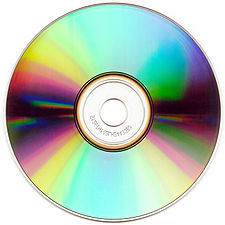
The 1990s were a revolutionary decade for digital technology. Between 1990 and 1997, household PC ownership in the US rose from 15% to 35%.[42] Cell phones of the early-1990s and earlier ones were very large, lacked extra features, and were used by only a few percent of the population of even the advanced nations. Only a few million people used online services in 1990, and the World Wide Web, which would have a significant impact on technology for many decades, had only just been invented. The first web browser went online in 1993.[43] By 2001, more than 50% of some Western countries had Internet access, and more than 25% had cell phone access.
Electronics and communications

- On 6 August 1991, CERN, a pan-European organization for particle research, publicized the new World Wide Web project.[44] Although the basic applications and guidelines that make the Internet possible had existed for almost two decades, the network did not gain a public face until the 1990s.
- Driven by mass adoption, consumer personal computer specifications increased dramatically during the 1990s, from 512 KB RAM 12 MHz Turbo XTs in 1990,[45] to 25–66 MHz 80486-class processor at the start of the popularization of the World Wide Web mid-decade,[46] to over 1 GHz CPUs with close to a gigabyte of RAM by 2000.
- Y2K spread fear throughout the United States and eventually the world in the last half of the decade, particularly in 1999, about possible massive computer malfunctions on 1 January 2000. As a result, many people stocked up on supplies for fear of a worldwide disaster. After significant effort to upgrade systems on the part of software engineers, no failures occurred when the clocks rolled over into 2000.
- Advancements in computer modems, ISDN, cable modems, and DSL led to faster connections to the Internet.
- The first Pentium microprocessor is introduced and developed by the Intel Corporation.
- Email becomes popular; as a result, Microsoft acquires the popular Hotmail webmail service.
- Instant messaging and the buddy list feature becomes popular. AIM and ICQ are two early protocols.
- Businesses start to build e-commerce websites; e-commerce-only companies such as Amazon.com, eBay, AOL, and Yahoo! grow rapidly.
- The introduction of affordable, smaller satellite dishes and the DVB-S standard in the mid-1990s expanded satellite television services that carried up to 500 television channels.
- The first MP3 player, the MPMan, is released in the late spring of 1998. It came with 32 MB of flash memory expandable to 64 MB. By the mid-2000s, the MP3 player would overtake the CD player in popularity.
- The first GSM network is launched in Finland in 1991.
- Digital single-lens reflex cameras and regular digital cameras become commercially available. They would replace film cameras by the mid-2000s.
- IBM introduces the 1-inch (25 mm) wide Microdrive hard drive in 170 MB and 340 MB capacities.
- Apple Computer in 1998 introduces the iMac all-in-one computer, initiating a trend in computer design towards translucent plastics and multicolour case design, discontinuing many legacy technologies like serial ports, and beginning a resurgence in the company's fortunes that continues to this day.
- CD burner drives are introduced.
- The CD-ROM drive became standard for most personal computers during the decade.
- The DVD media format is developed and popularized along with a plethora of Flash memory card standards in 1994.
- Pagers are initially popular but ultimately are replaced by mobile phones by the early-2000s.
- Hand-held satellite phones are introduced towards the end of the decade.
- The 24-hour news cycle becomes popular alongside the outbreak of the Gulf War between late 1990 and early 1991, and is solidified with CNN's coverage of Desert Storm and Desert Shield. Though CNN had been running 24-hour newscasts since 1980, it was not until the Gulf War that the general public took notice, and others imitated CNN's non-stop news approach.[47]
- Portable CD players, introduced during the late 1980s, became very popular and profoundly impacted the music industry and youth culture during the 1990s.
A typical early 1990s personal computer.
An early portable CD player, a Sony Discman model D121.
Pagers became widely popular.
Software
- Microsoft Windows operating systems become virtually ubiquitous on IBM PC compatibles.
- Microsoft introduces Windows 3.1, Windows 95, and Windows 98 to the market, which gain immediate popularity.
- Macintosh System 7 was released in 1991. For much of the decade, Apple would struggle to develop a next-generation graphical operating system, starting with Copland and culminating in its December 1996 buyout of NeXT and the 1999 release of Mac OS X Server 1.0.
- The development of web browsers such as Netscape Navigator and Internet Explorer makes surfing the World Wide Web easier and more user-friendly.
- The Java programming language is developed by Sun Microsystems (later acquired by Oracle in 2009–2010).
- In 1991, development of the free Linux kernel is started by 21-year-old Linus Torvalds in Finland.
- SolidWorks computer-aided design software for Windows released in 1995.
- Macromedia Shockwave Player for multimedia in browsers released in 1995.
- Winamp media player first released 1997.
- QuickTime media player created 1991.
Rail transportation
The opening of the Channel Tunnel between France and the United Kingdom saw the commencement by the three national railway companies of Belgium, France, and the United Kingdom, respectively SNCB/NMBS, SNCF and British Rail of the joint Eurostar service.
On 14 November 1994 Eurostar services began between Waterloo International station in London, Gare du Nord in Paris and Brussels South in Brussels.[48][49][50] In 1995 Eurostar was achieving an average end-to-end speed of 171.5 km/h (106.6 mph) between London and Paris.[51] On 8 January 1996 Eurostar launched services from a second railway station in the UK when Ashford International was opened.[52] Journey times between London and Brussels were reduced by the opening of the High Speed 1 line on 14 December 1997.
Automobiles
The 1990s began with a recession that dampened car sales. General Motors suffered huge losses because of an inefficient structure, stale designs, and poor quality. Sales improved with the economy by the mid-1990s, but GM's US market share gradually declined to less than 40% (from a peak of 50% in the 1970s). While the new Saturn division fared well, Oldsmobile fell sharply, and attempts to remake the division as a European-style luxury car were unsuccessful.
Cars in the 1990s had a rounder, more streamlined shape than those from the 1970s and 1980s; this style would continue early into the 2000s and to a lesser extent later on.
Chrysler ran into financial troubles as it entered the 1990s. Like GM, the Chrysler too had a stale model lineup (except for the best-selling minivans) that were largely based on the aging K-car platform. In 1992, chairman Lee Iacocca retired, and the company began a remarkable revival, introducing the new LH platform and "Cab-Forward" styling, along with a highly successful redesign of the full-sized Dodge Ram in 1994. Chrysler's minivans continued to dominate the market despite increasing competition. In 1998, Daimler-Benz (the parent company of Mercedes-Benz) merged with Chrysler. The following year, it was decided to retire Plymouth, which had been on a long decline since the 1970s. Ford continued to fare well in the 1990s, with the second and third generations of the Ford Taurus being named the best-selling car in the United States from 1992 to 1996. However, the Taurus would be outsold and dethroned by the Toyota Camry starting in 1997, which became the best-selling car in the United States for the rest of the decade and into the 2000s. Ford also introduced the Ford Explorer, with the first model being sold in 1991. Ford's Explorer became the best-selling SUV on the market, outselling both the Chevy Blazer and Jeep Cherokee.
Japanese cars continued to be highly successful during the decade. The Honda Accord vied with the Taurus most years for being the best-selling car in the United States during the early decade. Although launched in 1989, the luxury brands Lexus and Infiniti began car sales of 1990 model year vehicles and saw great success. Lexus would go on to outsell Mercedes-Benz and BMW in the United States by 1991 and outsell Cadillac and Lincoln by the end of the decade. SUVs and trucks became hugely popular during the economic boom in the decade's second half. Many manufacturers that had never built a truck before started selling SUVs. Fabrication during the 1990s became gradually rounder and ovoid, the Ford Taurus and Mercury Sable being some of the more extreme examples. Safety features such as airbags and shoulder belts became mandatory equipment on new cars.
Science
- Physicists develop M-theory.
- Detection of extrasolar planets orbiting stars other than the Sun.
- In the United Kingdom, the first cloned mammal, Dolly the sheep was confirmed by the Roslin Institute, and was reported by global media on 26 February 1997. Dolly would trigger a raging controversy on cloning, and bioethical concerns regarding possible human cloning continue to this day.[53]
- Human Genome Project begins under the leadership of Francis Collins.
- DNA identification of individuals finds wide application in criminal law. Brazil, United States, United Kingdom, Russia and The Netherlands established their own national DNA database.
- Hubble Space Telescope was launched in 1990 and revolutionized astronomy. Unfortunately, a flaw in its main mirror caused it to produce fuzzy, distorted images. This was corrected by a Space Shuttle repair mission in 1993.
- Protease inhibitors introduced, allowing HAART therapy against HIV; drastically reduces AIDS mortality.
- NASA's spacecraft Pathfinder lands on Mars and deploys a small roving vehicle, Sojourner, which analyzes the planet's geology and atmosphere.
- The Hale–Bopp comet swings past the Sun for the first time in 4,200 years in April 1997.
- Development of biodegradable products, replacing products made from polystyrene foam; advances in methods for recycling of waste products (such as paper, glass, and aluminum).
- Genetically engineered crops are developed for commercial use.
- Discovery of dark matter, dark energy, brown dwarfs, and first confirmation of black holes.
- The Galileo probe orbits Jupiter, studying the planet and its moons extensively.
- Comet Shoemaker–Levy 9 (formally designated D/1993 F2, nicknamed String of Pearls for its appearance) was a comet that broke apart and collided with Jupiter in July 1994, providing the first direct observation of an extraterrestrial collision of Solar System objects.
- The Global Positioning System (GPS) becomes fully operational.
- Proof of Fermat's Last Theorem is discovered by Andrew Wiles.
- Construction started in 1998 on the International Space Station.
Society
The 1990s represented continuing social liberalization in most countries, coupled with an increase in the influence of capitalism, which would continue until the Great Recession of the late 2000s/early 2010s.
- Youth culture in the 1990s responded to this by embracing both environmentalism and entrepreneurship. Fashion of the Western world reflected this by often turning highly individualistic and/or counter-cultural, which was influenced by Generation X and early millennials: tattoos and body piercings gained popularity, and "retro" styles, inspired by fashions of the 1960s and 1970s, were also prevalent. Some young people became increasingly involved in extreme sports and outdoor activities that combined embracing athletics with the appreciation of nature.
- In 1990 the World Health Organization removed homosexuality from its list of diseases.[54] Increasing acceptance of openly homosexual people occurred in the western world, slowly starting in the early 1990s,[55] Biphobia towards bisexual men became somewhat fashionable amongst heterosexual women and gay men, while lesbians and bisexual women complained of being commodified by publishing and film industries to cater to heterosexual men.
- Following the murder of actress Rebecca Schaeffer by a stalker, America's first anti-stalking laws, including California Penal Code 646.9 were passed in 1990. California also passed the first cyberstalking law in 1999 (§646.9 of the California Penal Code).
- Transdisciplinarity in academia. The 1st World Congress of Transdisciplinarity, Convento da Arrabida, was in Portugal, November 1994.
- Child abduction warnings on emergency broadcasting systems, such as Amber Alerts became standard in such cases.
- Midlife crisis is a major concern in domestic violence, social implications and suicides for middle-aged adults in the 1990s.
- Aggressive marketing tactics for psychoactive drugs and used to treat ADHD, inappropriate prescribing by doctors.
Environment
At the beginning of the decade, sustainable development and environmental protection became serious issues for governments and the international community. In 1987, the publication of the Brundtland Report by the United Nations paved the way to establish an environmental governance. In 1992, the Earth Summit was held in Rio de Janeiro, in which several countries committed to protect the environment, signing a Convention on Biological Diversity.
The prevention of the destruction of the tropical rainforests of the world is a major environmental cause that first came into wide public concern in the early 1990s and has continued and accelerated in its prominence.
The Chernobyl disaster had significant impact on public opinion at the end of the 1980s, and the fallout was still causing cancer deaths well into the 1990s and possibly even into the 21st century.[56] Well into the 1990s, several environmental NGOs helped improve environmental awareness among public opinion and governments. The most famous of these organizations during this decade was Greenpeace, which did not hesitate to lead illegal actions in the name of environmental preservation. These organizations also drew attention to the large deforestation of the Amazon rainforest during the period.
Global warming as an aspect of climate change also became a major concern, and the creation of the United Nations Framework Convention on Climate Change (UNFCCC) after the Earth Summit helped coordinate efforts to reduce carbon emissions in the atmosphere. From 1995, the UNFCCC held annual summits on climate change, leading to the adoption of the Kyoto Protocol in December 1997, a binding agreement signed by several developed countries.[57]
The 1989 EPA total ban on asbestos was overturned in 1991.[58]
In 1996, (Anderson, et al. v. Pacific Gas & Electric, file BCV 00300) alleged contamination of drinking water with hexavalent chromium and the case was settled for (US) $333 million, a new record for a direct-action lawsuit.
Third-wave feminism
- Anita Hill and other women testify before the United States Congress on being sexually harassed by Supreme Court nominee Clarence Thomas. Thomas was narrowly confirmed by the United States Senate, but Hill's testimony, and the testimony of other harassed women, begins a national debate on the issue.
- Record numbers of women are elected to high office in the United States in 1992, the "Year of the Woman."
- Violence against women takes centre stage as an essential issue internationally. The Violence Against Women Act was passed in the United States, which greatly affected the world community through the United Nations. The law's author, Joe Biden, UN Ambassador and Secretary of State Madeleine Albright, and Hillary Clinton (see below) have become vocal advocates of action against violence against women.
- Women reach great heights of power in the United States government. Hillary Clinton, leading policy proposals, traveling abroad as a State Department representative to 82 nations, advising her husband, and being elected a Senator (in 2000), is the most openly empowered and politically powerful First Lady in American history; Madeleine Albright and Janet Reno take two of the cabinet's top jobs as United States Secretary of State (#1), and United States Attorney General (#4), respectively. Sheila Widnall becomes head and United States Secretary of the Air Force of the Air Force, and Ruth Bader Ginsburg joins Sandra Day O'Connor as the second woman on the U.S. Supreme Court.
- More nations than ever before are led by elected women Presidents and Prime Ministers. Prime Minister Benazir Bhutto's 1988 victory in Pakistan makes great strides for women leaders in Muslim states. In Turkey, Tansu Çiller became the first female prime minister in 1993.
- In popular culture, British pop group the Spice Girls also played a part in the feminist movement, boosting popularity with their slogan "Girl Power!", while country music superstar Shania Twain declared female supremacy in her 1995 hit song "Any Man of Mine."
Baby boomers
Marketing campaigns aimed at young adults in wealthy English Speaking Countries were informed by unscientific theories about selling to so-called Generation X and Baby boomers. Few people embraced the labels Generation X and Baby Boomer as self-descriptors. Films with characters depicting the Generation X stereotype included Slacker, The Brady Bunch Movie and Austin Powers.
Substance abuse
- In Western countries, Fashion and Music magazines embrace heroin chic.
- Peak in numbers of heroin overdose deaths.
- An estimated fifty percent of deaths of 15-54 in post-Soviet Russia are blamed on alcohol abuse.[59]
- More restrictions on tobacco advertising in some countries.
Slavery and human trafficking
See: History of slavery, Global Slavery Index, Slavery in contemporary Africa, Slavery in Asia, Debt bondage in India, Child labour in Pakistan, Sex trafficking in China, Nike sweatshops
- Pakistan
Pakistan's government passed laws to end caste based slavery: - 1992 Bonded Labour System (Abolition) Act. - 1995 Bonded Labour System (Abolition) Rules.
Civil rights
- Saudi Arabia: Women to drive movement. 6 November 1990, 47 Saudi women in Riyadh protested Saudi government's ban on women drivers.
- United States: 1992 Rosa Parks: My Story, the autobiography of Rosa Parks is published.
Additional significant events
- Worldwide New Year's Eve celebrations on December 31, 1999, welcoming the year 2000.
Europe
- 1991 – January Events (Lithuania) – Soviet Union military troops attack Lithuanian independence supporters in Vilnius, killing 14 people and wounding 1000.
- In Paris, Diana, Princess of Wales and her friend, Dodi Al-Fayed, were killed in a car accident in August 1997, when their chauffeured, hired Mercedes-Benz S-Class crashed in the Pont de l'Alma tunnel. The chauffeur, Henri Paul, died at the scene, as did Al-Fayed. Diana and an Al-Fayed bodyguard, Trevor Rees-Jones, survived the accident. The Princess of Wales died at a Paris hospital hours later. The bodyguard, Rees-Jones, is the sole survivor of the now infamous accident.[60]
- Mother Teresa, the Roman Catholic nun who won the Nobel Peace Prize, dies at age 87.[61]
- The birth of the "Second Republic" in Italy, with the Mani Pulite investigations of 1994.
- The Channel Tunnel across the English Channel opens in 1994, connecting France and England. (As of 2022) it is the third-longest rail tunnel in the world, but with the undersea section of 37.9 km (23.5 mi) being the longest undersea tunnel in the world.
- The resignation of President Boris Yeltsin on 31 December 1999 resulted in Prime Minister Vladimir Putin's succession to the position.
North America
- Eric Harris and Dylan Klebold kill 13 people and then themselves during the Columbine High School shooting in April 1999, which would inspire a number of future school shooters to commit similar offenses.
- O. J. Simpson murder case – O. J. Simpson's trial, described in the American media as the "trial of the century", proceeds for nearly a year under intense media publicity. A majority of the trial was broadcast nightly during prime time television. On October 3, 1995, Simpson was found not guilty of the double-murder of ex-wife Nicole Brown Simpson and her friend, Ronald Goldman.
- With help from clinical fertility drugs, an Iowa mother, Bobbie McCaughey, gave birth to the first surviving septuplets in 1997. There followed a media frenzy and widespread support for the family.
- John F. Kennedy Jr., his wife Carolyn Bessette and sister-in-law Lauren Bessette are killed when Kennedy's private plane crashes off the coast of Martha's Vineyard in July 1999.
- Debate on assisted suicide, highly publicized by Michigan doctor Jack Kevorkian, surfaces when Kevorkian is charged with multiple counts of homicide of his terminally ill patients through the decade.
- Beer keg registration becomes a popular public policy in the United States.
- The 500th anniversary of Christopher Columbus' purported discovery of the Americas in 1992 was popularly observed in the United States, despite controversy and protests against the victimization of Native Americans by Columbus' expeditions. The holiday was labeled by some as racist, in view of Native American experiences of colonialism, slavery, genocide, and cultural destruction.
- Matthew Shepard is murdered near the University of Wyoming, purportedly for being gay. This sparks intense national and international media attention and outrage. Shepard becomes a major symbol in the LGBT rights movement and the fight against homophobia. Claims of crystal methamphetamine related "meth rage" as a contributing factor in the crime surfaced in 2013.[62]
- Shanda Sharer was murdered on January 11, 1992. She was lured away from her house and held captive by a group of teenage girls. She was tortured for hours and burned alive. She died from smoke inhalation. Those found guilty and sentenced to prison were Melinda Loveless, Laurie Tackett, Hope Rippey, and Toni Lawrence. According to Loveless, she was jealous of her former partner Amanda Heavrin's relationship with Sharer Sharer.[citation needed]
- Karla Homolka was arrested with her husband, Paul Bernardo, in 1993. Both sexually tortured and killed their victims. Their first victim was Karla's 15-year-old sister, Tammy Homolka. The second and third victims were Leslie Mahaffy and Kristen French. Karla told the investigators that she reluctantly did what Paul told her to do because he was abusive, and was given a plea deal. She was sentenced to 12 years in prison (10 years for Mahaffy and French, and two years for Tammy). Later, investigators discovered the crime videotapes, proving that Karla was a willing participant. But by that time the deal had already been made. In 1995, Paul was sentenced to life in prison. Karla was released from prison in 2005.
- Polly Klaas (January 3, 1981 – October 1993) was kidnapped by Richard Allen Davis from her home during a slumber party. She was later strangled to death. After her death, her father, Marc Klaas, established the KlaasKids Foundation.
- Jonbenet Ramsey (August 6, 1990 – December 25, 1996) was a child beauty pageant contestant who was missing and found dead in her Boulder, Colorado, home. The crime terrified the nation and the world. Her parents were initially considered to be suspects in her death but were cleared in 2003 when DNA from her clothes was tested. To this day, her murderer has not been found and brought to justice.
- Lorena Bobbitt was charged with malicious wounding for severing her husband John Bobbitt's penis after she was repeatedly sexually assaulted by Bobbitt, for which he was charged. Both parties were acquitted of their respective crimes. The story was notable because of the use of Microsurgery to re-attach the man's penis.
- Wanda Holloway was convicted of solicitation of capital murder when she attempted to hire a hitman to kill the mother of her daughter's junior high school cheerleading rival.
- American singer-songwriter, guitarist, and actor John Denver died in a plane crash in Monterey Bay near Pacific Grove on October 12, 1997.
- Scandal rocked the sport of figure skating when skater Nancy Kerrigan was attacked during practice by an assailant hired by Jeff Gillooly, former husband of skater Tonya Harding. The attack was carried out in an attempt to injure Kerrigan's leg to the point of her being unable to compete in the upcoming 1994 Winter Olympics, thereby securing Harding a better spot to win a gold medal.
- 1992 Los Angeles riots – resulted in 53 deaths and 5,500 property fires in a 100-square-mile (260 km2) riot zone. The riots were a result of the state court acquittal of three white and one Hispanic L.A. police officer by an all-white jury in a police brutality case involving motorist Rodney King. In 1993, all four officers were convicted in a federal civil rights case.
Asia
- Massive immigration wave of Jews from the Commonwealth of Independent States to Israel – With the end of the Soviet Union, Israel faced a mass influx of Russian Jews, many of whom had high expectations the country was unable to meet. Israel also came under an Iraqi missile attack during the Gulf War but acquiesced to US pressure not to retaliate militarily, which could have disrupted the US-Arab alliance. The US and Netherlands then rushed anti-missile batteries to Israel to defend the country against missile attacks.
- The Spratly Islands issue became one of the most controversial islands in Southeast Asia.
- The closing Mass of the X World Youth Day 1995 was held in Rizal Park on 15 January 1995, attended by more than 5 million people. This is the record gathering of the Roman Catholic Church.
- The Philippines celebrates the 100th anniversary of Philippine Independence in 1998 with its theme: "Kalayaan: Kayamanan ng Bayan."
Popular culture
The fourth and fifth generation of video game consoles like PlayStation, Sega Genesis and Saturn, and Super Nintendo and N64 (pictured) were a hit in the 1990s. Video games like Super Mario World and 64, Sonic The Hedgehog, Street Fighter II, Mortal Kombat, Donkey Kong Country, Final Fantasy VII, Tekken 3, Gran Turismo, Crash Bandicoot, Spyro The Dragon, Half-Life, Tony Hawk's Pro Skater and Doom were all popular.
The Dreamcast (Sega's final video game console) launched in Japan in 1998, and launched in North America and Europe the following year. The system saw the release of games like Sonic Adventure and Soulcalibur.
Popular cartoons of the 1990s included Doug, Rugrats, Beavis and Butt-Head, Daria, Goof Troop, Bonkers, Arthur, Ren & Stimpy, Hey Arnold!, Rocko's Modern Life, Tiny Toon Adventures, Animaniacs, The Simpsons, Dexter's Laboratory, Johnny Bravo, Cow and Chicken, The Powerpuff Girls, and The Twisted Tales of Felix the Cat
Grunge was a genre of music and subculture popular in the 1990s, as modeled here by Krist Novoselic (left) and Kurt Cobain of the band Nirvana, one of the most influential bands of the decade. Pearl Jam, Soundgarden and Alice in Chains were also popular bands of this genre.
Technological advancements like the internet, personal computers, and the World Wide Web were popular in the 1990s. The Y2K bug in the late 1990s affected popular culture. Y2K was a computer bug occurring when computers switched from the years 1999 to 2000, some computers reset to 1900.
In the 1990s videotapes were used for personal home video recordings and recording television airings. VHS tapes could be put in devices such as VCRs, which were popular in the decade.
Pokémon Red, Blue, and Yellow released in the late 1990s, which launched the globally popular Pokémon franchise, pictured above the GameBoy cartridges.
Five Olympic Games were held in the 1990s, Albertville and Barcelona in 1992, Lillehammer in 1994, Atlanta in 1996 and Nagano in 1998 (all held in the post-Cold War decade).
The "Disney Renaissance" of the 1990s produced critically and commercially successful animated films like the first ever CGI motion picture Toy Story (produced with Pixar), and traditionally animated films such as Beauty and the Beast, Aladdin and The Lion King, later it was adapted into live-action remakes.
Shibuya became Tokyo's popular youth hangout in the 1990s, part of the Heisei Power cultural movement during the Lost Decades in Japan.
Popular computing softwares like Windows 95 and 98 by Microsoft defined 1990s aesthetics.
The 1990s saw the use of earlier internet search engines, such as Google in its infancy, JumpStation, Ask.com, and AltaVista.
Film
Dogme 95 became an important European artistic motion picture movement by the decade's end. Also in 1998, Titanic (released in late 1997) became the highest-grossing film of all time, grossing over $1.8 billion worldwide. It would hold this record for over a decade until 2010 when director James Cameron's Avatar (released in December 2009), took the title.[63]
Crime films were also extremely popular during the 1990s and garnered several awards throughout the decade, such as Wild at Heart, Goodfellas, Pulp Fiction, Fargo, L.A. Confidential, Heat, The Godfather Part III, Seven, Trainspotting, A Simple Plan, and many others.
Live-action films featuring computer-animated characters became popular, with films such as Casper, James and the Giant Peach, 101 Dalmatians, Men in Black, Small Soldiers and Stuart Little proving financially successful. Live-action/traditional cel animated film featuring traditional characters like Cool World, The Pagemaster and Space Jam were prevalent as well.
Animated films
In 1994, former Disney employee Jeffrey Katzenberg founded DreamWorks SKG, which would produce its first two animated films: The Prince of Egypt and Antz which were both aimed more at adults than children and were both critically and commercially successful. Toy Story, the first full-length CGI movie, made by Pixar, was released in 1995 and revolutionized animated films. In 1998, with the release of DreamWorks's Antz and Pixar's A Bug's Life, the rivalry between DreamWorks and Pixar began between the studios due to the similarities between both films.
Meanwhile, films by Pixar's parent company, Disney became popular once more when the studio returned to making family-oriented animated musical films. Disney Animation was navigating the "Disney Renaissance", through both animated theatrical films and animated television series on the Disney Channel (owned by Walt Disney Television). The "Disney Renaissance" began with The Little Mermaid in 1989 and ended with Tarzan in 1999. Films of this era include Beauty and the Beast, Aladdin, The Nightmare Before Christmas, The Lion King, Pocahontas, The Hunchback of Notre Dame, Hercules, and Mulan.
Japanese anime films remained popular throughout the 1990s with the release of Studio Ghibli films such as Only Yesterday, Porco Rosso, Pom Poko, Whisper of the Heart, Princess Mononoke (which became the highest-grossing anime film at the time) and My Neighbors the Yamadas. Other significant anime films which gained cult status include Roujin Z, Ramayana: The Legend of Prince Rama, Patlabor 2: The Movie, Ninja Scroll, Street Fighter II: The Animated Movie, Ghost in the Shell, Memories, The End of Evangelion, Perfect Blue, Jin-Roh: The Wolf Brigade, and the Pokémon film series, which started with Pokémon: The First Movie.
Other significant animated films have also gained cult status, such as The Jetsons Movie, The Princess and the Goblin, Happily Ever After, An American Tail: Fievel Goes West, Ferngully: The Last Rainforest, Tom and Jerry: The Movie, The Thief and the Cobbler, Once Upon a Forest, We're Back! A Dinosaur's Story, Batman: Mask of the Phantasm, Felidae, The Swan Princess, A Goofy Movie, Balto, Beavis and Butt-Head Do America, Cats Don't Dance, Anastasia, Quest for Camelot, The Rugrats Movie, Kirikou and the Sorceress, The King and I, South Park: Bigger, Longer, Uncut and The Iron Giant. Family-centric animated feature films began to gain popularity through the late-1990s (1997, 1998, and 1999). Don Bluth's animation studio released a number of underperforming family animated films such as Rock-a-Doodle, Thumbelina and The Pebble and the Penguin and closed down in 1995.
In India,Shah Rukh Khan got rise in his stardom by Dilwale Dulhania Le Jayenge,Kuch Kuch Hota Hai and Dil To Pagal Hai.
Award winners
| Award | 1990 | 1991 | 1992 | 1993 | 1994 | 1995 | 1996 | 1997 | 1998 | 1999 |
|---|---|---|---|---|---|---|---|---|---|---|
| Academy Award for Best Picture winners | Dances with Wolves[64] | The Silence of the Lambs[65] | Unforgiven[66] | Schindler's List[67] | Forrest Gump[68] | Braveheart[69] | The English Patient[70] | Titanic[71] | Shakespeare in Love[72] | American Beauty[73] |
| Palme d'Or winners at the Cannes Film Festival | ||||||||||
| César Award for Best Film winners | Cyrano de Bergerac | Tous les matin du monde | Savage Nights | Smoking/No Smoking | Wild Reeds | La haine | Ridicule | Same Old Song | The Dreamlife of Angels | Venus Beauty Institute |
| Golden Lion winners at the Venice Film Festival | Rosencrantz & Guildenstern Are Dead | Close to Eden | The Story of Qiu Ju | Short Cuts and Three Colours: Blue | Vive L'Amour and Before the Rain | Cyclo | Michael Collins | Fireworks | The Way We Laughed | Not One Less |
Highest-grossing
The 25 highest-grossing films of the decade are:[74]
| No. | Title | Year | Box office |
|---|---|---|---|
| 1 | Titanic | 1997 | $1,850,197,130 |
| 2 | Star Wars: Episode I – The Phantom Menace | 1999 | $924,305,084 |
| 3 | Jurassic Park | 1993 | $912,667,947 |
| 4 | Independence Day | 1996 | $817,400,891 |
| 5 | The Lion King | 1994 | $763,455,561 |
| 6 | Forrest Gump | 1994 | $677,387,716 |
| 7 | The Sixth Sense | 1999 | $672,806,292 |
| 8 | The Lost World: Jurassic Park | 1997 | $618,638,999 |
| 9 | Men in Black | 1997 | $589,390,539 |
| 10 | Armageddon | 1998 | $553,709,788 |
| 11 | Terminator 2: Judgment Day | 1991 | $516,950,043 |
| 12 | Ghost | 1990 | $505,702,588 |
| 13 | Aladdin | 1992 | $504,050,219 |
| 14 | Twister | 1996 | $494,471,524 |
| 15 | Toy Story 2 | 1999 | $487,059,677 |
| 16 | Saving Private Ryan | 1998 | $481,840,909 |
| 17 | Home Alone | 1990 | $476,684,675 |
| 18 | The Matrix | 1999 | $463,517,383 |
| 19 | Pretty Woman | 1990 | $463,406,268 |
| 20 | Mission: Impossible | 1996 | $457,696,391 |
| 21 | Tarzan | 1999 | $448,191,819 |
| 22 | Mrs. Doubtfire | 1993 | $441,286,195 |
| 23 | Dances with Wolves | 1990 | $424,208,848 |
| 24 | The Mummy | 1999 | $415,933,406 |
| 25 | The Bodyguard | 1992 | $410,945,720 |
Music
Music artists and genres
Music marketing became more segmented in the 1990s, as MTV gradually shifted away from music videos and radio splintered into narrower formats aimed at various niches.[75][76][77][78] However, the 1990s are perhaps best known for grunge, gangsta rap, R&B, teen pop; Eurodance, electronic dance music, the renewed popularity of punk rock from the band Green Day and their 1994 album Dookie (which would also help create a new genre pop punk), and for the entrance of alternative rock into the mainstream. U2 was one of the most popular 1990s bands; their groundbreaking Zoo TV and PopMart tours were the top-selling tours of 1992 and 1997, respectively. Glam metal died out in the music mainstream by 1991.[79] Grunge became popular in the early 1990s due to the success of Nirvana's Nevermind, Pearl Jam's Ten, Alice in Chain's Dirt, Soundgarden's Badmotorfinger and Stone Temple Pilot's Core.[80] Pop punk also becomes popular with such artists as Green Day, Blink-182, Weezer, Social Distortion, The Offspring, Bad Religion, NOFX and Rancid.[81] Other successful alternative acts included Red Hot Chili Peppers, R.E.M., Nickelback, Creed, Radiohead, Gin Blossoms, Soul Asylum, Third Eye Blind, Faith No More, The Smashing Pumpkins, Live, Everclear, Bush, Screaming Trees and Ween.[82]
Rappers Salt-n-Pepa continued to have hit songs until 1994. Dr. Dre's 1992 album The Chronic provided a template for modern gangsta rap, and gave rise to other emerging artists of the genre, including Snoop Dogg.[83] Due to the success of Death Row Records and Tupac Shakur, West Coast gangsta rap commercially dominated hip hop during the early-to-mid 1990s, along with Bad Boy Records and the Notorious B.I.G. on the East Coast.[84] Hip hop became the best-selling music genre by the mid-1990s.[85][86]
1994 became a breakthrough year for punk rock in California, with the success of bands like Bad Religion, Social Distortion, Blink-182, Green Day, the Offspring, Rancid and similar groups following. This success would continue to grow over the next decade. The 1990s also became the most important decade for ska punk/reggae rock, with the success of many bands like Smash Mouth, Buck-O-Nine, Goldfinger, Less Than Jake, the Mighty Mighty Bosstones, Murphy's Law, No Doubt, Reel Big Fish, Save Ferris, Sublime and Sugar Ray.
The rave movement that emerged in the late 1980s continued to grow in popularity. This movement spawned genres such as Intelligent dance music and Drum and bass. The latter is an offshoot of jungle techno and breakbeat. Popular artists included Moby, Fatboy Slim, Björk, Aphex Twin, Orbital, the Orb, the Chemical Brothers, Basement Jaxx, Todd Terry, 808 State, Primal Scream, the Shamen, the KLF and the Prodigy.
The rise of industrial music, somewhat a fusion of synthpop and heavy metal, rose to worldwide popularity with bands like Godflesh, Nine Inch Nails, Rammstein, Ministry and Marilyn Manson. Groove metal was born through the efforts of Pantera, whose seventh studio album Far Beyond Driven (1994) was notable for going number one on Billboard 200. Another heavy metal subgenre called nu metal, which mixed metal with hip hop influences, became popular with bands like Korn, Slipknot and Limp Bizkit selling millions of albums worldwide. Metallica's 1991 eponymous album Metallica is the best-selling album of the SoundScan era, while extreme metal acts such as Death, Mayhem, Darkthrone, Emperor, Cannibal Corpse and others experienced popularity throughout the decade.
Country music
In the 1990s, country music became a worldwide phenomenon thanks to Billy Ray Cyrus, Shania Twain and Garth Brooks.[87][88][89] The latter enjoyed one of the most successful careers in popular music history, breaking records for both sales and concert attendance throughout the decade. The RIAA has certified his recordings at a combined (128× platinum), denoting roughly 113 million United States shipments.[90]
Other artists that experienced success during this time included Clint Black, Sammy Kershaw, Aaron Tippin, Travis Tritt, Suzy Bogguss, Alan Jackson, Lorrie Morgan and the newly formed duo of Brooks & Dunn. George Strait, whose career began in the 1980s, also continued to have widespread success in this decade and beyond. Female artists such as Reba McEntire, Faith Hill, Martina McBride, Deana Carter, LeAnn Rimes and Mary Chapin Carpenter all released platinum-selling albums in the 1990s. Rimes, a teenager at the time, spawned a "teen movement" in country music; with fellow teen artists Lila McCann, Jessica Andrews, Billy Gillman, and others following suit; a feat that hasn't been duplicated since Tanya Tucker and Marie Osmond in the early 1970s. The Dixie Chicks became one of the most popular country bands in the 1990s and early 2000s. Their 1998 debut album Wide Open Spaces went on to become certified 12× platinum, while their 1999 album Fly went on to become 10× platinum.
Music from around the world
In the United Kingdom, the alternative rock Britpop genre emerged as part of the more general Cool Britannia culture, with Oasis, Blur, Pulp, Suede, Supergrass, Elastica, the Verve, Ash, Ocean Colour Scene and Kula Shaker serving as popular examples of this emergence. The impact of boy band pop sensation Take That lead to the formation of other boy bands in the UK and Ireland, such as East 17 and Boyzone. Female pop icons Spice Girls took the world by storm, becoming the most commercially successful British group since the Beatles, the Rolling Stones and Led Zeppelin.[91][92] Also, R&B artists Des'Ree, Mark Morrison and Sade became quite popular during this decade. Their global success brought about a widespread scene of teen pop acts around the world[93][94] such as All Saints, Backstreet Boys, Hanson, NSYNC, Britney Spears and Christina Aguilera who came to prominence into the new millennium.[95] 1991 also saw the death of Queen frontman Freddie Mercury from AIDS-related pneumonia. Many musicians from Canada, such as Celine Dion, Maestro Fresh Wes, Snow, Barenaked Ladies, Shania Twain, Len, Sarah McLachlan, and Alanis Morissette became known worldwide.
In Japan, the J-pop genre emerged as part of the more general Heisei Power cultural movement, with B'z, Mr. Children, Southern All Stars, Yumi Matsutoya, Dreams Come True, Glay, Zard, Hikaru Utada, Namie Amuro, SMAP, Chage and Aska, L'Arc-en-Ciel, Masaharu Fukuyama, Globe, Tube, Kome Kome Club, Maki Ohguro, Tatsuro Yamashita, TRF, Speed, Wands, and Field of View became more popular for Japanese youth audiences during the Lost Decades.
Contemporary quiet storm and R&B continued to be quite popular among adult audiences originating from African-American communities, which began during the 1980s. Popular African-American contemporary R&B artists included Mariah Carey, D'Angelo, Lauryn Hill, Whitney Houston, Brandy, En Vogue, TLC, Destiny's Child, Toni Braxton, Boyz II Men, Dru Hill, Vanessa Williams and Janet Jackson.
The Tibetan Freedom Concert, organized by Beastie Boys and the Milarepa Fund, brought 120,000 people together in the interest of increased human rights and autonomy for Tibet from China.
Controversies
Controversy surrounded the Prodigy with the release of the track "Smack My Bitch Up". The National Organization for Women (NOW) claimed that the track was "advocating violence against women" due to the song's lyrics, which are themselves sampled from Ultramagnetic MCss' Give the Drummer Some. The music video (directed by Jonas Åkerlund) featured a first-person POV of someone going clubbing, indulging in drugs and alcohol, getting into fist fights, abusing women and picking up a prostitute. At the end of the video, the camera pans over to a mirror, revealing the subject to be a woman.
Deaths of artists
Freddie Mercury, Kurt Cobain, Selena, Eazy-E, Tupac Shakur and the Notorious B.I.G. were the most publicized music-related deaths of the decade, in 1991, 1994, 1995, 1996, and 1997 respectively. Richey Edwards of Manic Street Preachers was publicized in the media in 1991 following an incident involving Steve Lamacq backstage after a live show, in which Edwards carved '4 Real' into his arm. Edwards' disappearance in 1995 was highly publicized. He is still missing but was presumed dead in 2008.
Television
- Comedies and sitcoms
TV shows, mostly sitcoms, were popular with American audiences. Series such as Roseanne, Coach, Empty Nest, Mr. Belvedere, 227, Cheers, The Cosby Show, Growing Pains, Night Court, The Hogan Family, Murphy Brown, Full House, The Wonder Years, A Different World, Amen, ALF, Perfect Strangers, Married... with Children, Family Matters, Charles in Charge, Saved by the Bell, My Two Dads, Major Dad, Newhart, Dear John, Designing Women, The Golden Girls, Who's the Boss?, Head of the Class, and Seinfeld, which premiered in the eighties, and Frasier, a spin-off of the 1980s hit Cheers were viewed throughout the 1990s.
These sitcoms, along with Friends, That '70s Show, Ellen, The Fresh Prince of Bel-Air, Nurses, Living Single, Step by Step, NewsRadio, Blossom, The King of Queens, Fired Up, Jesse, Parker Lewis Can't Lose, For Your Love, The Steve Harvey Show, The Larry Sanders Show, Sex and the City, Arliss, Dream On, Grace Under Fire, Mad About You, Sabrina the Teenage Witch, The Naked Truth, The Jeff Foxworthy Show, The Jamie Foxx Show, Smart Guy, The Wayans Bros., Malcolm & Eddie, Clueless, Moesha, The Parent 'Hood, Unhappily Ever After, Roc, Martin, Hangin' with Mr. Cooper, In Living Color, Sister, Sister, Boy Meets World, Ned and Stacey, Becker, Veronica's Closet, Two Guys and a Girl, The Drew Carey Show, Wings, The John Larroquette Show, Caroline in the City, Sports Night, Home Improvement, Will & Grace, Evening Shade, Cosby, Spin City, The Nanny, 3rd Rock from the Sun, Suddenly Susan, Cybill, Just Shoot Me!, Everybody Loves Raymond, and Dharma and Greg from the 90s turned TV in new directions and defined the humor of the decade.
Furthermore, Saturday Night Live experienced a new era of success during the 1990s, launching the careers of popular comedians and actors such as Chris Farley, Dana Carvey, Phil Hartman, Adam Sandler, Will Ferrell, Molly Shannon, Mike Myers, Chris Rock, Norm McDonald, David Spade, Cheri Oteri and others.
Drama shows
1993 saw the debut of the medical–mystery drama, Diagnosis Murder, a comeback vehicle for Dick Van Dyke, who guest-starred on an episode of its sequel, Jake and The Fatman, where the show got off to a rocky start and became one of television's long-running mysteries, that lasted until its cancellation in 2001.
Medical dramas started to come into television in the 1990s. In 1994, ER, which originally starred Anthony Edwards, Noah Wyle and George Clooney, was a domestic and international success, lasting until 2009 and spawned similar series such as Grey's Anatomy (2005–present). It made NBC the most-watched channel in the United States. This show launched the career of George Clooney. That same year, Chicago Hope, that starred Héctor Elizondo, Mandy Patinkin and Adam Arkin, was also a popular series for CBS, lasting between 1994 and 2000.
Crime drama and police detective shows returned to the spotlight after soap operas died down. After the successful debuts of Law & Order, NYPD Blue, Homicide: Life on the Street, Fox debuted New York Undercover, which starred Malik Yoba and Micheal DeLorenzo, is notable for featuring two people of color in the main roles. Nash Bridges, a comeback vehicle for Don Johnson, lasting six seasons (1996–2001), dealt with escapist entertainment instead of tackling social issues.[96]
Beverly Hills, 90210 ran on Fox from 1990 to 2000. It established the teen soap genre, paving the way for Dawson's Creek, Felicity, Party of Five, and other shows airing later in the decade. The show was then remade and renamed simply 90210 and premiered in 2008. Beverly Hills, 90210, and its spin-off Melrose Place also became a popular TV show throughout the 1990s. Baywatch became the most-watched TV show in history [citation needed] and influenced pop culture.
Sex and the City's portrayal of relationships and sexuality caused controversy and acclaim, leading to a new generation of sexually progressive television shows in the 2000s.
Other television shows and genres
Fantasy and science fiction shows were popular on television, with NBC airing SeaQuest DSV beginning in 1993, which made Jonathan Brandis a popular teen idol, but was cancelled after three seasons. The 1990s saw a multitude of Star Trek content: in 1993, following the success of Star Trek: The Next Generation, Paramount released the follow-up shows Star Trek: Deep Space Nine (1993–1999) and Star Trek: Voyager (1995–2001). Touched By an Angel, broadcast by CBS in 1994, was intended as the comeback vehicle of Della Reese, and also launched the career of Roma Downey. It wasn't an immediate success and was cancelled, but was revived the following year due to a fan letter-writing campaign, and ran for eight more seasons. At the end of the decade, the fantasy drama series Charmed gained a cult following and helped popularize the WB.
In 1993, one of the last westerns to air on television was Walker, Texas Ranger, a crime drama starring Chuck Norris as the title character. Running for nine seasons, the show tackled a wide variety of subjects and was one of few shows to feature an actor performing karate stunts at that time.
Reality television was not an entirely new concept (An American Family aired on PBS in 1973) but proliferated for Generation X audiences with titles such as Judge Judy, Eco-Challenge, and Cops.
The 1990s saw the debut of live-action children's programs such as the educational Bill Nye the Science Guy and Blue's Clues as well as the superhero show Mighty Morphin Power Rangers, the latter becoming a pop culture phenomenon along with a line of action figures and other toys by Japanese toy manufacturer Bandai. This can also be said for the British pre-school series Teletubbies, which was a massive hit loved by very young children. It also saw long time running shows such as Barney & Friends and the continuation of Seasme Street, both of which would continue in the following decades and so.
During the mid-1990s, two of the biggest professional wrestling companies: World Championship Wrestling and World Wrestling Federation were in a ratings battle that was called the Monday Night Wars (1995–2001). Each company fought to draw more viewers to their respective Monday night wrestling show. The "War" ended in 2001 when WWE bought WCW. In November 2001, there was a Winner Takes All match with both companies in a Pay-Per-View called Survivor Series. WWF won the match, putting an end to WCW.
The late 1990s also saw the evolution of a new TV genre: primetime game shows, popularized by the game show Who Wants to Be a Millionaire?, hosted originally by Chris Tarrant on ITV and Regis Philbin on ABC, as well as other first-run game shows aired in prime time on the newly launched Game Show Network.
Animated shows
An animated sitcom, The Simpsons, premiered on Fox in December 1989 and became a domestic and international success in the 1990s. The show has since aired more than 600 episodes and has become an institution of pop culture. In addition, it has spawned the adult-oriented animated sitcom genre, inspiring more adult-oriented animated shows such as Beavis and Butt-Head (1993–1997), Daria (1997–2001), along with South Park and Family Guy, the latter two of which began in 1997 and 1999, respectively, and continue to air new episodes through the 2000s and into the 2020s.
Cartoons produced in the 1990s are sometimes referred to as the "Renaissance Age of Animation" for cartoons in general, particularly for American animated children's programs. Disney Channel, Nickelodeon (owned by Viacom, now Paramount Global) and Cartoon Network (owned by Warner Bros. Discovery) would dominate the animated television industry. These three channels are considered the "Big Three", of children's entertainment, even today, but especially during the 1990s.
Other channels such as Warner Bros. Animation would create shows like Tiny Toon Adventures, Animaniacs, and the start of the DC Animated Universe with shows such as Batman: The Animated Series, and Superman: The Animated Series, as well as syndicated shows like Phantom 2040. Nickelodeon's first three animated series (Doug, Rugrats, The Ren & Stimpy Show) all premiered in 1991 along with shows such as Hey Arnold!, CatDog, The Wild Thornberrys, and in 1999 saw the debut of Nickelodeon's well known animated comedy series SpongeBob SquarePants. Cartoon Network would create shows like Dexter's Laboratory, The Powerpuff Girls, Ed, Edd n Eddy, Johnny Bravo, and Courage the Cowardly Dog. Disney Channel would made shows like Recess, Pepper Ann, Darkwing Duck, TaleSpin, and Gargoyles.
Japanese anime was popular in the 1980s and expanded to a worldwide audience by the 1990s for its expansive spectrum of story subjects and themes not limited to comedy and superhero action found in the US. It featured well-produced, well-written, visual, and story content that came to showcase animation's potential for emotional and intellectual depth and integrity on par with live action media to its viewers. Anime expanded to older and adult audiences in the medium of animation. Anime shows such as Sailor Moon, Digimon, Pokémon, Tenchi Muyo!, Berserk, Trigun, Cowboy Bebop, Gundam Wing, Neon Genesis Evangelion, Ranma ½, Yu Yu Hakusho, Slayers, Rurouni Kenshin, Initial D, Gunsmith Cats, Slam Dunk, Nadia: The Secret of Blue Water, Outlaw Star, to anime movies such as Akira, Vampire Hunter D, My Neighbor Totoro, Princess Mononoke, Castle in the Sky, The Castle of Cagliostro, and imports by various distributors such as Viz, AnimEigo, Central Park Media, A.D. Vision, Pioneer Entertainment, Media Blasters, Manga Entertainment, and Celebrity, helped begin the mid to late 1990s and turn of the millennium introductory anime craze in the US, and the Cartoon Network anime programming block Toonami in 1997.
Fashion and body modification
Significant fashion trends of the 1990s include:
- Earth and jewel tones, as well as an array of minimalist style and design influences, characterize the 1990s, a stark contrast to the camp and bombast seen in the brightly colored fashion and design trends of the 1980s.
- The Rachel, Jennifer Aniston's hairstyle on the hit TV show Friends, became a cultural phenomenon, with millions of women copying it worldwide.
- The Hi-top fade was trendy among African-Americans in the early 1990s.
- The Curtained Haircut increased in popularity in fashion and culture among teenage boys and young men in the 1990s, mainly after it was popularized in the film Terminator 2: Judgment Day by the actor Edward Furlong.
- The model 1300 Wonderbra style has a resurgence of popularity in Europe in 1992, which kicks off an international media sensation, the 1994 return of "The Wonderbra" brand, and a spike in the push-up, plunge bras around the world.
- Additional fashion trends of the 1990s include the Tamagotchi, Rollerblades, Pogs and Dr. Martens shoes.
- Bleached-blond hair became very popular in the late 1990s, as were men with short hair with the bangs "flipped up."
- The 1990s also saw the return of the 1970s teenage female fashion with long, straight hair and denim hot pants.
- Beverly Hills, 90210 sideburns also became popular in the early and mid-1990s.
- Slap bracelets were a popular fad among children, preteens, and teenagers in the early 1990s and were available in a wide variety of patterns and colors. Also popular among children were light-up sneakers, jelly shoes, and shoelace hair clips.
- The Grunge hype at the beginning of the decade popularized flannel shirts among both genders during the 1990s.
- Heroin chic appeared sporadically across film, fashion models and grunge music, but gave way by end of the US recession and the emergence of internet "geek" culture (a sassy tech-literate style centered on web searching and drinking coffee).
- Grunge- and hip-hop-inspired anti-fashion saw an expansion of the slouchy, casual styles of past decades, mostly seen in baggy and distressed jeans, cargo shorts and pants, baseball caps (often worn backward), chunky sneakers, oversized sweatshirts, and loose-fitting tees with grandiloquent graphics and logos.
- Svelte fashion was also popular from the beginning of the 1990s and into the 2000s, as the new millennium began. The rivalry of sloppy grunge fashion versus more expensive clothing made for fitter bodies was a repeat of the rock versus disco rivalry of a decade ago. Nineties fashion became darker, slinkier, and more futuristic-looking clothing in the late 1990s, with Keanu Reeves in The Matrix as a style icon.
- Tattoos and piercings became part of the mainstream aesthetic. American model Christy Turlington revealed her belly button piercing at a fashion show in London in 1993. In the late 1990s, some females got lower back tattoos and men opted for tribal style arm bands or back pieces.
Tamagotchi and Furby were popular iconic toys among children around the world in the 1990s, also in the 2000s
Video games
Video game consoles
Video game consoles released in this decade include the Super Nintendo Entertainment System, Neo Geo, Atari Jaguar, 3DO, Sega Saturn, PlayStation, Nintendo 64 and Dreamcast. Portable video game consoles include the Game Gear, Atari Lynx and Game Boy Color. Super Mario World was the decade's best-selling home console video game, while Pokémon Red and Blue was the decade's best-selling portable video game; Super Mario 64 was the decade's best-selling fifth-generation video game, while Street Fighter II was the decade's highest-grossing arcade video game.
The console wars, primarily between Sega (Mega Drive, marketed as the Sega Genesis in North America, introduced in 1988) and Nintendo (Super NES, introduced in 1990), sees the entrance of Sony with the PlayStation in 1994, which becomes the first successful CD-based console (as opposed to cartridges). By the end of the decade, Sega's hold on the market becomes tenuous after the end of the Saturn in 1999 and the Dreamcast in 2002.
Arcade games rapidly decreased in popularity, mainly due to the dominance of handheld and home consoles.[97]
Video games
Mario as Nintendo's mascot finds a rival in Sega's Sonic the Hedgehog with the release of Sonic the Hedgehog on the Sega Mega Drive/Genesis in 1991. Sonic the Hedgehog would go on to become one of the most successful video game franchises of the decade and of all time.
Notable video games of the 1990s include: Super Metroid, Metal Gear Solid, Super Mario World, Doom, Donkey Kong Country, Donkey Kong 64, Pokémon Red and Blue Versions, Pokémon Yellow Version, GoldenEye 007, Super Mario 64, The Legend of Zelda, Gran Turismo, Mario Kart 64, Half-Life, Super Mario Kart, Radiant Silvergun, Rayman, Gunstar Heroes, Banjo-Kazooie, Soulcalibur, Star Fox series, Tomb Raider series, Final Fantasy, Sonic the Hedgehog series, Story of Seasons series, Tony Hawk's series, Crash Bandicoot series, Metal Slug series, Resident Evil series, Street Fighter II, Spyro the Dragon series, Commander Keen series, Test Drive series, Dance Dance Revolution series, Monkey Island series, Dune series, Mortal Kombat series, Warcraft series, Duke Nukem 3D, Tekken series, EarthBound, Fallout: A Post Nuclear Role Playing Game, and StarCraft.
Sony's PlayStation becomes the top-selling video game console and changes the standard media storage type from cartridges to compact discs (CDs) in home consoles. Crash Bandicoot is released on September 9, 1996, becoming one of the most successful platforming series for the Sony PlayStation. Spyro The Dragon, released on September 9, 1998, also became a successful platforming series. Tomb Raider's Lara Croft became a video game sex symbol, becoming one of the most recognizable figures in the entertainment industry throughout the late 1990s.
Pokémon enters the world scene with the release of the original Pokémon Red and Pokémon Green for Game Boy in Japan in 1996, later changed to Pokémon Red and Pokémon Blue for worldwide release in 1998. It soon becomes popular in the United States and Canada , creating the term Pokémonia, and is adapted into a popular anime series and trading card game, among other media forms.
Resident Evil is released in 1996 and Resident Evil 2. Both games became the most highly acclaimed survival-horror series on the PlayStation at the time it was released. It is credited with defining the survival horror genre and with returning zombies to popular culture, leading to a renewed interest in zombie films by the 2000s.
Video game genres
3D graphics become the standard by the decade's end. Although FPS games had long since seen the transition to full 3D, other genres began to copy this trend by the end of the decade. The most notable first shooter games in the 1990s are GoldenEye 007 and Tom Clancy's Rainbow Six.
The violent nature of fighting games like Capcom's Street Fighter II, Sega's Virtua Fighter, and Midway's Mortal Kombat prompted the video game industry to accept a game rating system. Hundreds of knockoffs are widely popular in the mid-to-late 1990s. Doom (1993) bursts onto the world scene, and instantly popularizes the FPS genre. Half-Life (1998) builds upon this, using gameplay without levels and an immersive first-person perspective. Half-Life became one of the most popular FPS games in history.
The real-time strategy (RTS) genre is introduced in 1992 with the release of Dune II. Warcraft: Orcs & Humans (1994) popularizing the genre, and Command & Conquer and Warcraft II in 1995, setting up the first major real-time strategy competition and popularizing multiplayer capabilities in RTS games. StarCraft in 1998 becomes the second best-selling computer game of all time. It remains among the most popular multiplayer RTS games today, especially in South Korea . [citation needed] Homeworld in 1999 becomes the first successful 3D RTS game. The rise of the RTS genre is often credited with the fall of the turn-based strategy (TBS) genre, popularized with Civilization in 1991. Final Fantasy was introduced (in North America) in 1990 for the NES and remains among the most popular video game franchises, with many new titles to date and more in development, plus numerous spin-offs, sequels, films and related titles. Final Fantasy VII, released in 1997, especially popularized the series.
Massively multiplayer online role-playing games (MMORPGs) see their entrance with Ultima Online in 1997. However, they do not gain widespread popularity until EverQuest and Asheron's Call in 1999. MMORPGs become among the most popular video game genres until the 2010s.
The best-selling games of the 1990s are listed below (note that some sources disagree on particular years):
- 1990: Super Mario World[98]
- 1991: Sonic the Hedgehog[98]
- 1992: Super Mario Land 2[98]
- 1993: Super Mario All-Stars[98]
- 1994: Donkey Kong Country[98]
- 1995: Super Mario World 2: Yoshi's Island[98] or Mortal Kombat 3[99]
- 1996: Pokémon Red and Blue[98] or Super Mario 64[99]
- 1997: Gran Turismo[98] or Mario Kart 64[99]
- 1998: Pokémon Yellow[98] or The Legend of Zelda[99]
- 1999: Pokémon Gold and Silver[98] or Donkey Kong 64[99]
Super Nintendo Entertainment System (SNES) released in 1990 and is the successor to the Nintendo Entertainment System
The European PAL version of the Mega Drive launched in 1990, later becoming the highest-selling fourth-gen console in Europe.
Nintendo's Game Boy was a popular handheld game console during the 1990s.
The Atari Jaguar released in 1993, becoming part Fifth-gen of video game consoles.
The Nintendo 64 was released in 1996. Super Mario 64 was the best-selling game of the decade.
The PlayStation was released in the mid-1990s and became the best-selling gaming console of its time.
The game Tomb Raider, launched in 1996, became particularly popular during the decade and as a result Lara Croft's character eventually became a cultural icon in the video game industry
Internet
Prominent websites launched during the decade include IMDb (1993), eBay (1995), Amazon (1994), GeoCities (1994), Netscape (1994), Yahoo! (1995), AltaVista (1995), AIM (1997), ICQ (1996), Hotmail (1996), Google (1998), Napster (1999). The pioneering peer-to-peer (P2P) file sharing internet service Napster, which launched in Fall 1999, was the first peer-to-peer software to become massively popular. While at the time it was possible to share files in other ways via the Internet (such as IRC and USENET), Napster was the first software to focus exclusively on sharing MP3 files for music. Napster was eventually forced to shut down in July 2001 after legal disputes over copyright infringement and digital piracy, though it would eventually be relaunched as a music streaming service in 2016.
Architecture
- The Petronas Twin Towers became two of the tallest man-made structures ever built after they officially opened on August 31, 1999.
Sports
- In college football, the Inaugural 1992 SEC Championship Game occurred at Legion Field in Birmingham, Alabama. The Alabama Crimson Tide football team, under then-Coach Gene Stallings, went 11-0 and defeated the Florida Gators under then-Coach Steve Spurrier. The Tide would later finish 13–0 to win the National Championship and beat the Miami Hurricanes in the 1993 Sugar Bowl. However, Spurrier and the Gators would later win Four SEC Championships from 1993 to 1996. They went on to win their first National Championship in the 1997 Nokia Sugar Bowl by defeating the Florida State Seminoles.
- The 1992 Summer Olympics are held in Barcelona, Spain and the 1996 Summer Olympics are held in Atlanta, United States .
- The 1992 United States men's Olympic basketball team, nicknamed the "Dream Team", was the first American Olympic team to feature active professional players from the National Basketball Association. Described as the "greatest team ever assembled", its roster included the likes of Michael Jordan, Larry Bird, and Magic Johnson.[100][101]
- Major League Baseball players went on strike on August 12, 1994, thus ending the season and canceling the World Series for the first time in 90 years. The players' strike ended on March 29, 1995, when players and team owners agreed.
- The 1991 World Series pitted the Atlanta Braves and the Minnesota Twins, two teams who finished last place in their respective divisions, the previous season. The series would go all seven games won by the home teams, concluding dramatically with the Minnesota Twins claiming their second World Series title.
- American NBA basketball player Michael Jordan became a major sports and pop culture icon, idolized by millions worldwide. He revolutionized sports marketing through deals with companies such as Gatorade, Hanes, McDonald's and Nike. His Chicago Bulls team won six NBA titles during the decade (1991, 1992, 1993, 1996, 1997 and 1998). He was also notable outside of basketball thanks to his self-portrayal in the film Space Jam with the Looney Tunes characters.
- The National Hockey League would expand from 21 to 30 teams. During the expansion years, several teams would relocate to new cities: the Winnipeg Jets moved to Phoenix, Arizona and became the Phoenix Coyotes, the Quebec Nordiques moved to Denver and became the Colorado Avalanche, the Hartford Whalers moved to Raleigh, North Carolina and became the Carolina Hurricanes, and the Minnesota North Stars moved to Dallas and became the Dallas Stars.
- The NHL's 1990s expansion saw new teams in cities that previously never had NHL hockey: San Jose (San Jose Sharks), Anaheim (Mighty Ducks of Anaheim), Nashville (Nashville Predators), Miami (Florida Panthers), and Tampa (Tampa Bay Lightning). The NHL also returned to Atlanta with the expansion Atlanta Thrashers.
- Two of the NHL's Original Six teams, the New York Rangers and the Detroit Red Wings, would end long Stanley Cup championship droughts; the Rangers in 1994 after 54 years, and the Red Wings would win back-to-back Cups in 1997 and 1998 after 42 years.
- Canadian hockey star Mario Lemieux led the Pittsburgh Penguins, one of the original NHL expansion teams, to back-to-back Stanley Cup championships in 1991 and 1992.
- In addition to the Pittsburgh Penguins, three other NHL expansion teams went on to earn their first Stanley Cup championships: the New Jersey Devils in 1995, the Colorado Avalanche in 1996, and the Dallas Stars in 1999.
- Canadian hockey star Wayne Gretzky announced his retirement from the NHL in 1999. Upon his final game on April 18, he held 40 regular-season records, 15 playoff records, and six All-Star records. He is the leading point-scorer in NHL history and the only NHL player to total over 200 points in one season – a feat he accomplished four times. In addition, he tallied over 100 points in 16 professional seasons, 14 of them consecutive. He played for four teams during his NHL career: the Edmonton Oilers, the Los Angeles Kings, the St. Louis Blues, and the New York Rangers.
- American cyclist Lance Armstrong won his first Tour de France in 1999, less than two years after battling testicular cancer. Armstrong would later become embattled in a major doping investigation, stripping him of this and all of his major cycling titles.
- In professional wrestling, as the popularity brought on by the 1980s boom period slowly declined in the former half of the 1990s, the WWF continued its "Golden Era" until 1993, led by such stars as Hulk Hogan, The Ultimate Warrior, and The Undertaker (who would go on to have an undefeated streak at WrestleMania that continued until WrestleMania XXX in April 2014). Afterwards, a second boom period from the middle of the decade was initiated due to the Monday Night Wars between the WWF and WCW to later spawn the WWF's Attitude Era, home to some of the biggest names in wrestling history such as Stone Cold Steve Austin, The Rock, and Triple H. Meanwhile, the highly popular nWo stable, along with Sting and Goldberg, brought WCW major success.
- The Manchester United won an unprecedented treble of the Premier League, FA Cup and Champions League after defeating Bayern Munich 2–1 in May 1999.
- The United States hosted the 15th staging of the 1994 FIFA World Cup. It holds the record for the largest attendance per game during the World Cup finals (even after the tournament's expansion to 32 teams and 64 matches). Additionally, this led to the creation of the MLS.
- In motor racing, triple Formula One World Champion Ayrton Senna is fatally injured in a crash at San Marino in 1994. Michael Schumacher enters into the sport – winning his first two championships in 1994 and 1995. Dale Earnhardt wins the 1998 Daytona 500 and the NASCAR Winston Cup championship in 1990, 1991, 1993, and 1994. Indy Car racing delves into an organizational "Split".
- In the NFL, the San Francisco 49ers and the Washington Redskins showed promise of continuing their '80s glory by each team winning another Super Bowl at the beginning of the decade. However, it was the Dallas Cowboys who made a gradual return to dynasty status, winning three Super Bowls (1992, 1993 and 1995) in four years after a 14-year NFL championship drought. The Denver Broncos also won their first two Super Bowls after having lost four, winning consecutive championships of the 1997 and 1998 seasons.
- Florida State, 1987–2000 – At the height of Bobby Bowden's dominance, the Florida State Seminoles went 152–19–1, won nine ACC championships (1992–2000), two national championships (1993 and 1999), played for three more national championships (1996, 1998, and 2000), were ranked #1 in the preseason AP poll five times (1988, 1991, 1993, 1995, and 1999), never lost the #1 AP ranking during 1999, produced 20 1st round NFL draft picks (including the 1997 offensive and defensive rookies of the year), won at least ten games every year, and never finished a season ranked lower than fourth in the AP poll. Quarterbacks Charlie Ward and Chris Weinke won Heisman Trophies.[102]
- The Nebraska Cornhuskers led by head coach Tom Osborne won three national championships in college football in four years (1994, 1995, 1997)
- Led by head coach Jim Tressel, The Youngstown State Penguins claimed to be the "team of the '90s" by winning four national championships (1991, 1993, 1994, 1997) in division I-AA college football[103]
- The Ultimate Fighting Championship (1993) and Pride Fighting Championship (1997) debut and evolve into the modern sport of Mixed Martial Arts.
- Major League Baseball added four teams, Miami Marlins (as Florida Marlins), Colorado Rockies, Tampa Bay Rays (as Tampa Bay Devil Rays), and the Arizona Diamondbacks, and moved one (Milwaukee Brewers) into the National League. The Florida Marlins would win the World Series in 1997 and 2003; the Arizona Diamondbacks would win the World Series in 2001, becoming the fastest expansion team to win a major championship for any major sport; the Colorado Rockies and Tampa Bay Rays would appear in the World Series in 2007 and 2008 respectively.
- In 1998, Canada wins gold medals for the first time in Disc ultimate at the WFDF World Ultimate Championship in Open, Mixed, and Masters.
- In the 1996 Summer Olympics, the Women's Gymnastics team won the first team gold medal for the US in Olympic Gymnastics history.
- In 1997, eight Australian Rugby League Premiership clubs defect to the News Corporation-backed Super League, before a resolution sees the two parties form the National Rugby League in 1998. The British competition is bought out by News Corporation, and renamed Super League, which it is still currently named (although it was sold by News Corporation).
Literature
- Leading talk show host Oprah Winfrey became an important book influencer in 1996 when she launched the highly successful Oprah's Book Club.
- The hugely successful Harry Potter series by J. K. Rowling was introduced in 1997. The series, with seven main novels, would go on to become the best-selling book series in world history and adapted into a film series in 2001.
- John Grisham was the bestselling author in the United States in the 1990s, with over 60 million copies sold of novels such as The Pelican Brief, The Client, and The Firm.[104]
- Other successful authors of the 1990s include Stephen King, Danielle Steel, Michael Crichton, James Redfield, Haruki Murakami, Keigo Higashino and Tom Clancy.[104]
- Goosebumps by R. L. Stine, the second highest-grossing book series in the world, was introduced in 1992 and remained a dominant player in children's literature throughout and after the decade. A television series released on Fox Kids alongside a film version that released in 2015.
- The decline of diverse study options in university humanities schools due to economic rationalism, leading to a boom in purple prose heavily influenced by 20th century European social theory and cultural studies. In 1996 in what is known as the Sokal affair, a mathematician pranked a cultural studies by tricking them into publishing his nonsensical essay "Transgressing the Boundaries: Towards a Transformative Hermeneutics of Quantum Gravity" on the basis that the journal wasn't peer-reviewed and would publish anything that seemed fashionably left-wing. In 1996 the Postmodernism Generator used a recursive transition network to imitate the postmodernist style of humanities writing.
- 1990s saw the rise of independent literature and notable self-help books, included Men Are from Mars, Women Are from Venus by John Gray and Who Moved My Cheese? by Spencer Johnson.
People
Actors and directors
- Ben Affleck
- Jason Alexander
- Tim Allen
- María Conchita Alonso
- Benyamin Sueb
- Gillian Anderson
- Pamela Anderson
- Jennifer Aniston
- Christina Applegate
- Rosanna Arquette
- Rowan Atkinson
- Kevin Bacon
- Alec Baldwin
- Antonio Banderas
- Christopher Daniel Barnes
- Roseanne Barr
- Drew Barrymore
- Kim Basinger
- Angela Bassett
- Sean Bean
- Elizabeth Berkley
- Sandra Bernhard
- Halle Berry
- Kathryn Bigelow
- Powers Boothe
- Ernest Borgnine
- Avery Brooks
- Pierce Brosnan
- Clancy Brown
- Sandra Bullock
- Rodger Bumpass
- Tim Burton
- Brett Butler
- Yancy Butler
- Gabriel Byrne
- James Caan
- Nicolas Cage
- Dean Cain
- Chen Kaige
- James Cameron
- Neve Campbell
- Drew Carey
- George Carlin
- Jim Carrey
- Dana Carvey
- Jackie Chan
- Dave Chappelle
- George Clooney
- Tim Conway
- Coen brothers
- Sean Connery
- Kevin Costner
- Courteney Cox
- Marcia Cross
- Tom Cruise
- Billy Crystal
- Macaulay Culkin
- Vondie Curtis-Hall
- Matt Damon
- Frank Darabont
- Robert Davi
- Ellen DeGeneres
- Robert De Niro
- Johnny Depp
- Danny DeVito
- Leonardo DiCaprio
- Shannen Doherty
- Kirk Douglas
- Brad Dourif
- Fran Drescher
- Léa Drucker
- David Duchovny
- Kirsten Dunst
- Charles S. Dutton
- Clint Eastwood
- Anthony Edwards
- Peter Falk
- Chris Farley
- William Fagerbakke
- David Faustino
- Abel Ferrara
- Will Ferrell
- Laurence Fishburne
- Calista Flockhart
- Harrison Ford
- Jodie Foster
- Dennis Franz
- Brendan Fraser
- Morgan Freeman
- Edward Furlong
- Eva Gabor
- James Gandolfini
- Janeane Garofalo
- Jennie Garth
- Sarah Michelle Gellar
- Mel Gibson
- Peri Gilpin
- Danny Glover
- Whoopi Goldberg
- Jeff Goldblum
- Trevor Goddard
- John Goodman
- Joseph Gordon-Levitt
- Mark-Paul Gosselaar
- Kelsey Grammer
- Brian Austin Green
- Graham Greene
- Thomas Ian Griffith
- Arsenio Hall
- Linda Hamilton
- Tom Hanks
- Curtis Hanson
- Phil Hartman
- Woody Harrelson
- Ed Harris
- Teri Hatcher
- Rutger Hauer
- Ethan Hawke
- Mitch Hedberg
- Lance Henriksen
- Bill Hicks
- Agnieszka Holland
- Anthony Hopkins
- Dennis Hopper
- Helen Hunt
- Jeremy Irons
- Samuel L. Jackson
- Jennifer Jason Leigh
- Angelina Jolie
- Tommy Lee Jones
- Shekhar Kapur
- Tchéky Karyo
- Michael Keaton
- Harvey Keitel
- Tom Kenny
- Nicole Kidman
- Krzysztof Kieślowski
- Val Kilmer
- Greg Kinnear
- Lisa Kudrow
- Eriq La Salle
- Carolyn Lawrence
- Doug Lawrence
- Martin Lawrence
- Matt LeBlanc
- Ang Lee
- Spike Lee
- Jane Leeves
- Valérie Lemercier
- Jay Leno
- Jared Leto
- David Letterman
- Ted Levine
- Jet Li
- Rachael Lillis
- Delroy Lindo
- John Lithgow
- Heather Locklear
- Mario Lopez
- Julia Louis-Dreyfus
- Dolph Lundgren
- Michael Madsen
- Bill Maher
- John Mahoney
- Julianna Margulies
- Steve Martin
- John McTiernan
- Demi Moore
- Julianne Moore
- Joe Morton
- Kate Mulgrew
- Eddie Murphy
- Mike Myers
- Hideo Nakata
- Liam Neeson
- Craig T. Nelson
- Bob Newhart
- Aaron Norris
- Chuck Norris
- Bill Nunn
- Conan O'Brien
- Ed O'Neill
- Gary Oldman
- Jerry Orbach
- Gwyneth Paltrow
- Robert Patrick
- Alexandra Paul
- Chris Penn
- Sean Penn
- Ron Perlman
- Luke Perry
- Matthew Perry
- Joe Pesci
- Michelle Pfeiffer
- River Phoenix
- David Hyde Pierce
- Brad Pitt
- Kevin Pollak
- Jason Priestley
- Alex Proyas
- Dennis Quaid
- Randy Quaid
- Keanu Reeves
- Paul Reiser
- Michael Richards
- Alan Rickman
- Tim Robbins
- Eric Roberts
- Julia Roberts
- Chris Rock
- Michael Rooker
- Mickey Rourke
- Tim Roth
- RuPaul
- Kurt Russell
- Rene Russo
- Meg Ryan
- Winona Ryder
- Katey Sagal
- Bob Saget
- Adam Sandler
- Susan Sarandon
- Arnold Schwarzenegger
- David Schwimmer
- Steven Seagal
- Jerry Seinfeld
- Garry Shandling
- Charlie Sheen
- Elisabeth Shue
- Sarah Silverman
- Tony Sirico
- Christian Slater
- Will Smith
- Jimmy Smits
- Wesley Snipes
- David Spade
- Tori Spelling
- Steven Spielberg
- Sage Stallone
- Sylvester Stallone
- John Stamos
- Jon Stewart
- Patrick Stewart
- Sharon Stone
- Meryl Streep
- Patrick Swayze
- Ice-T
- Jeffrey Tambor
- Quentin Tarantino
- Veronica Taylor
- Tiffani-Amber Thiessen
- Uma Thurman
- Jennifer Tilly
- Tony Todd
- Danny Trejo
- John Travolta
- Robin Tunney
- Jean-Claude Van Damme
- Dick Van Dyke
- Gus Van Sant
- Arnold Vosloo
- Christopher Walken
- Fred Ward
- Denzel Washington
- Sam Waterston
- Sigourney Weaver
- Hugo Weaving
- Vernon Wells
- Forest Whitaker
- Michael Jai White
- Robin Williams
- Bruce Willis
- Rita Wilson
- Oprah Winfrey
- Michael Winterbottom
- John Woo
- James Woods
- Noah Wyle
- Robert Zemeckis
- Ian Ziering
Athletes
- Andre Agassi
- Troy Aikman
- Lance Armstrong
- Steve Austin
- Roberto Baggio
- Charles Barkley
- Barry Bonds
- Martin Brodeur
- Roger Clemens
- David Douillet
- Dale Earnhardt
- John Elway
- Patrick Ewing
- Brett Favre
- Tom Glavine
- Bill Goldberg
- Graham Gooch
- Jeff Gordon
- Steffi Graf
- Wayne Gretzky
- Ken Griffey Jr.
- Tony Hawk
- Grant Hill
- Evander Holyfield
- Michael Irvin
- Jaromír Jágr
- Derek Jeter
- Randy Johnson
- Chipper Jones
- Michael Jordan
- Jim Kelly
- Jürgen Klinsmann
- Michelle Kwan
- Brian Lara
- Mario Lemieux
- Greg LeMond
- Greg Maddux
- Karl Malone
- Mark Messier
- Reggie Miller
- Tommy Morrison
- Alonzo Mourning
- Hakeem Olajuwon
- Shaquille O'Neal
- Gary Payton
- Scottie Pippen
- Dino Rada
- Jerry Rice
- Cal Ripken Jr.
- David Robinson
- Dennis Rodman
- Romário
- Ronaldo
- Patrick Roy
- Joe Sakic
- Pete Sampras
- Barry Sanders
- Deion Sanders
- Peter Schmeichel
- Michael Schumacher
- Ayrton Senna
- Alan Shearer
- Brendan Shanahan
- Kelly Slater
- Michael Slater
- Emmitt Smith
- John Smoltz
- John Stockton
- Sachin Tendulkar
- Mike Tyson
- Jacques Villeneuve
- Tiger Woods
- Steve Yzerman
- Zinedine Zidane
- Mika Häkkinen
Musicians
Musical trends of the 1990s decade are identifiable by its top selling pop songs as well as continuing the heyday for established genres such as gangsta rap, grunge, industrial rock and deep house. Alternative hip hop became visible at the start of the decade. The pulblic was sympathetic to independent music as a solution to the problem of payola in commercial radio stations.
- A
- Aaliyah
- Aaron Carter
- Aaron Kwok
- Abby Travis
- Abrar-ul-Haq
- AC/DC
- Ace of Bass
- Adamski
- Adina Howard
- Adorable
- Aerosmith
- The Afghan Whigs
- A Guy Called Gerald
- Alanis Morissette
- Alan Jackson
- Alejandro Fernández
- Alex Party
- Alice Cooper
- Alice Deejay
- Alice In Chains
- Alisha Chinai
- Alison Krauss
- Altern-8
- Agalloch
- Amber
- Amelina
- American Football
- Amr Diab
- Amy Grant
- Ana Bárbara
- Andy Lau
- ...And You Will Know Us by the Trail of Dead
- Andy Prieboy
- Angélique Kidjo
- Ani Difranco
- Annie Lennox
- Another Bad Creation
- Anthony Braxton
- Anuradha Sriram
- Apache Indian
- Aphex Twin
- Aqua
- Archers of Loaf
- Archie Roach
- Arrested Development
- ATB
- Autechre
- Army of Lovers
- Athena Cage
- The Atomic Fireballs
- A Tribe Called Quest
- Az Yet
- Azzido Da Bass
- Babacar
- Babes in Toyland
- Baby Animals
- Babylon Zoo
- Bachelor Girl
- Backstreet Boys
- Bailter Space
- Bali Brahmbhatt
- Bally Sagoo
- Barenaked Ladies
- Barry Adamson
- Beastie Boys
- Beasts of Bourbon
- Beck
- Belly
- Ben Folds Five
- Ben Harper
- The Beta Band
- Beth Orton
- Better Than Ezra
- Beyond
- Bhavatharini
- Bhitali Das
- Big Bad Voodoo Daddy
- Bigod 20
- Big Pig
- Big Pun
- Bikini Kill
- Bill Dixon
- Billie Piper
- Billy Bragg
- Billy Ray Cyrus
- Bim Sherman
- Binary Finary
- Biohazard
- Biosphere
- Bizarre Inc
- Bjork
- The Black Crowes
- Black Francis
- Black Grape
- Black Star
- Blackstreet
- Blessed Union of Souls
- Blind Melon
- Blink-182
- Bloodhound Gang
- Blue Boy
- Blumfeld
- Blur
- Boards of Canada
- Bob Sinclar
- Body Count
- Bombay Vikings
- Bone Thugs-n-Harmony
- Bongwater
- Bonnie Raitt
- The Boo Radleys
- Bootsy Collins
- Boredoms
- Boss
- Boss Hog
- Boyz II Men
- Boyzone
- Brand New Heavies
- Brand Nubian
- Brandon Ross
- Brandy
- The Breeders
- The Brian Jonestown Massacre
- The Brian Setzer Orchestra
- Britney Spears
- Bronco
- Bryan Adams
- Buckethead
- Buckshot LeFonque
- Buena Vista Social Club
- Bugge Wesseltoft
- Bung (Canadian band)
- Bush
- Busta Rhymes
- Butthole Surfers
- Café Tacvba
- Cake
- Caifanes
- Capleton
- Cap'n Jazz
- Captain Hollywood Project
- Carl Cox
- Carlene Carter
- Carlos Vives
- Caroline's Spine
- Carter Burwell
- The Cardigans
- Cast
- Catatonia
- Catherine Wheel
- Cathy Dennis
- Cat Power
- C+C Music Factory
- CeCe Peniston
- Celine Dion
- Charles & Eddie
- Charles Gayle
- Charly Lownoise and Mental Theo
- Chayanne
- Cheba Zahouania
- Cheb Hasni
- Cheb Mami
- Cheb Nasro
- Cheer-Accident
- The Chemical Brothers
- Cher
- Cherry Poppin' Daddies
- Chicane
- The Chills
- Chris Knox
- Christian Falk
- Chuck Berry
- Chumbawamba
- The Church
- Chyi Chin
- C. J. Bolland
- Clay Walker
- The Clouds
- Clutch
- Coco Lee
- Cocteau Twins
- CoH
- Coil
- Collin Raye
- Collapsed Lung
- Collective Soul
- Color Me Badd
- Company Flow
- Concrete Blonde
- The Connells
- Controlled Bleeding
- Coolio
- Cop Shoot Cop
- Corona
- The Corrs
- Counting Crows
- Cows
- Cracker
- Cradle of Filth
- The Cranberries
- Crash Test Dummies
- Creed
- Crime and the City Solution
- Crooklyn Dodgers
- The Crystal Method
- Crystal Waters
- The Cruel Sea
- Crush (British group)
- Culture Beat
- The Cure
- Current 93
- Curtis Stigers
- Curve
- Cycle Sluts from Hell
- Cypress Hill
- Dada
- Daft Punk
- Da Hool
- Daler Mehndi
- Dana Lyons
- Dandy Warhols
- Daniel Johnston
- Danny Breaks
- Darkthrone
- Darren Styles
- Dave Graney and the Coral Snakes
- Dave Matthews
- David Lee Murphy
- The Dead C
- Deadeye Dick
- Deadly Venoms
- Deana Carter
- Deconstruction
- Death Cab for Cutie
- Deee-Lite
- Deep Forest
- Deep Blue Something
- Deep Dish
- Def FX
- Def Squad
- Deftones
- De La Soul
- Depeche Mode
- Destiny's Child
- Des'ree
- Devang Patel
- Devin Townsend
- Diamanda Galas
- Diana Haddad
- Diana King
- Diana Krall
- Diana Ross
- Diane Warren
- Dido
- Digable Planets
- Digital Underground
- Dim Stars
- Dimitri from Paris
- Dinosaur Jr.
- Dionne Farris
- Dionne Warwick
- Dirty Three
- The Divine Comedy
- Divinyls
- Dishwalla
- Dixie Chicks
- DJ Class
- DJ Jubilee
- DJ Muggs
- DJ Shadow
- DJ Spooky
- DMX
- Dodgy
- Dom & Roland
- Don Henley and Patty Smyth
- Donna Lewis
- Donell Jones
- Doolally
- Dope
- Dot Allison
- Double 99
- Doug Stone
- Dr. Dre
- Dread Zeppelin
- Dream Theater
- Dreem Teem
- Drexciya
- Drive Like Jehu
- Dru Hill
- Dub Syndicate
- Duncan Sheik
- Dune
- Eagle Eye Cherry
- East 17
- Eazy-E
- EC8OR
- Ednaswap
- Edwyn Collins
- Eels
- Ehab Tawfik
- Eiffel 65
- El-B
- Electro Assassin
- Electronic
- Elliott Smith
- Elton John
- El Vez
- Elvis Crespo
- EMF
- Eminem
- Energy 52
- Enigma
- Enrique Iglesias
- Entombed
- En Vogue
- Ephraim Lewis
- EPMD
- Erasure
- Eric Person
- Erykah Badu
- Eternal
- Everclear
- Everlast
- Everything but the Girl
- Extreme
- Failure
- Faith Evans
- Faith Hill
- Faithless
- Falling Joys
- The Family Cat
- The Farm
- Fastball
- Fatboy Slim
- The Fauves
- Fear Factory
- Feeder
- Feedtime
- Felix da Housecat
- Fey
- Filter
- Finitribe
- Fishbone
- Fishmans
- Fiona Apple
- Fits of Gloom
- Five
- Fluke
- The Flying Neutrinos
- The Folk Implosion
- Foo Fighters
- 4 Non Blondes
- Fountains of Wayne
- Fragma
- Frank De Wulf
- Frankie Knuckles
- Frank Ski
- Free Kitten
- Frente!
- Fridge
- Fuel
- Fugazi
- Fugees
- Fun Lovin' Criminals
- Fuzzy
- Gabrielle
- Galliano
- Gallon Drunk
- Gang Starr
- Garbage
- Garth Brooks
- Gerardo
- George Harrison
- George Lamond
- George Ramogi
- George Straight
- Geraldine Fibbers
- The Getaway People
- Geto Boys
- Gianfranco Bortolotti
- Gianluca Grignani
- Gilette
- Gin Blossoms
- Gina G
- Gloria Estefan
- Godflesh
- God Is My Co-Pilot
- Godsmack
- Godspeed You! Black Emperor
- Goo Goo Dolls
- Gouryella
- Graeme Revell
- Green Day
- Green Jellÿ
- Groove Armada
- Groove Theory
- Grupo Bryndis
- Gruntruck
- Gumball
- Guns N' Roses
- Gwar
- Haddaway
- The Hafler Trio
- The Hacker
- Hallucinogen
- Hamid Al Shaeri
- Hamid Drake
- Happy Mondays
- Hardfloor
- Harini
- Harry Connick Jr.
- Harry Dennis
- Harvey Danger
- The Heights
- Helen Rogers
- Helios Creed
- Helmet
- Hema Sardesai
- Henry Kaiser
- Henryk Górecki
- Herbie Crichlow
- Héroes del Silencio
- Hilmar Örn Hilmarsson
- Hisham Abbas
- Hole
- Hootie and the Blowfish
- The House of Love
- House of Pain
- Howard Shore
- Huffamoose
- Hum
- Human Nature
- Human Waste Project
- Hux Flux
- Ian Moore
- Ice Cube
- Incubus
- Infectious Grooves
- Iggy Pop
- Ini Kamoze
- Inkuyo
- Inner Circle
- Inner City
- Insane Clown Posse
- Insurge
- Iwan Fals
- Jack off Jill
- Jacky Cheung
- Jagged Edge
- Jagjit Singh
- Jam & Spoon aka Tokyo Ghetto Pussy
- James
- Jamiroquai
- Jane's Addiction
- Janet Jackson
- Jarboe
- Jawbreaker
- Jaydee
- Jay-Z
- Jebediah
- Jeff Buckley
- Jellyfish
- Jennifer Lopez
- Jennifer Paige
- Jesus Jones
- The Jesus Lizard
- Jill Sobule
- Jimmy Cliff
- Jimmy Eat World
- Jimmy Nail
- Joan Osborne
- Jodeci
- Joe Diffie
- Joey Beltram
- John Adams
- John Butler
- John Delafose
- Johnny Hallyday
- Joi Cardwell
- Jonathan Wolff
- Jon Bon Jovi
- Jon Secada
- Jon Spencer Blues Explosion
- José Carreras and Sarah Brightman
- Josh Wink
- Juliana Hatfield
- June Panic
- Junior Kimbrough
- Jurassic 5
- Kabah
- Kai Tracid
- Kamaya Painters
- Kataklysm
- K-Ci & JoJo
- k.d. lang
- Keb' Mo'
- Keep the Dog
- Keith Murray
- Keith Sweat
- Kelis
- Kenny Chesney
- Kenny Dope (The Bucketheads)
- Kelly Chen
- Kerri Chandler
- Kev Carmody
- Khaled
- King Missile
- King Sunny Adé
- Killing Heidi
- Kirk Franklin
- Kirsty MacColl
- The KLF
- KMD
- KMFDM
- Kool Keith
- Korn
- Kris Kross
- K-Swift
- Kula Shaker
- Kumar Sanu
- KWS
- Kylie Minogue
- La Bouche
- Lacuna Coil
- Laibach
- La Ley
- Lamb
- Lange
- Larry Heard
- Larry Levan
- The La's
- LaTour
- Laura Pausini
- Laurent Garnier
- Lauryn Hill
- LeAnn Rimes
- Lee Kernaghan
- Leftfield
- The Lemonheads
- Len
- Lenny Dee, Ralphy Dee
- Lenny Kravitz
- Leon Lai
- Leslie Cheung
- Lil Kim
- Lil Louis
- Limbomaniacs
- Limp Biskit
- Lisa Loeb
- Lit
- Little Annie
- Live
- The Living End
- Livin' Joy
- Lizband
- Liz Phair
- Local H
- Lo Fidelity Allstars
- Lo'Jo
- Londonbeat
- Lords of Acid
- Lordz of Brooklyn
- Los Del Rio
- Los Prisioneros
- Lou Reed and John Cale
- The Lox
- L7
- Lucinda Williams
- Lucky Ali
- Lucky Dube
- Luka Bloom
- Lungfish
- Lunachicks
- Luniz
- Luscious Jackson
- Lush
- Luther Vandross
- Lost Tribe
- Lycia
- Lydia Lunch and Rowland S. Howard
- Lyle Lovett
- Macy Gray
- Mad Caddies
- Madison Avenue
- Madonna
- Madredeus
- Magic Dirt
- Main Source
- Mandy Moore
- Manic Street Preachers
- Mariah Carey
- Marc Anthony
- Marc Cohn
- Marco Antonio Solís
- Mark Chesnutt
- Mark Morrison
- Mark Snow
- Marky Mark and the Funky Bunch
- Marilyn Manson
- Marmoset
- Marta Sánchez
- Martha Wash
- Martina McBride
- The Martinis
- Mary Chapin Carpenter
- Mary J. Blige
- Mase
- Massive Attack
- Masters at Work
- Matchbox Twenty
- Matthew Sweet
- The Mavis's
- Maxi Priest
- Max Sharam
- Mazzy Star
- MC Hammer
- MC Solaar
- Meat Beat Manifesto
- Meat Loaf
- Meat Puppets
- Melissa Etheridge
- Melissa Tkautz
- Melt-Banana
- Melvin Gibbs
- Melvins
- Members of Mayday
- Mercury Rev
- Meredith Brooks
- Meshell Ndegeocello
- Messiah
- Metallica
- MF Doom
- Michael Bolton
- Michael Franti
- Michael Jackson
- Michael Nyman
- The Mighty Mighty Bosstones
- Mike Post
- Miracle Legion
- Miss Kittin
- Missy Elliot
- M. M. Keeravani
- Moby
- Modest Mouse
- Mogwai
- Moist
- Moloko
- Monie Love
- Monica
- Monifah
- Monster Magnet
- Montell Jordan
- Moodymann
- Moonshake
- M People
- Morbid Angel
- Morcheeba
- Morphine
- Morrissey
- Mos Def
- Mouse on Mars
- Moustafa Amar
- Mr Bungle
- Mr. Vegas
- Mr Velcro Fastener
- My Bloody Valentine
- My Friend the Chocolate Cake
- My Life With The Thrill Kill Kult
- My Sister's Machine
- Mystic
- Mystikal
- Nada Surf
- Najwa Karam
- Naked City
- Nalin & Kane
- Nas
- Natalie Imbruglia
- Natalie Merchant
- Naughty by Nature
- Nawal Al Zoghbi
- The Necks
- Ned's Atomic Dustbin
- Neneh Cherry
- New Radicals
- Next
- Nick Cave and the Bad Seeds
- Niels van Gogh
- Nigel Kennedy
- Nightmares on Wax
- Nike Ardilla
- Nine Inch Nails
- Nitocris
- Nitzer Ebb
- Nirvana
- N-Joi
- No Doubt
- Noël Akchoté
- No Mercy
- Nonchalant
- The Notorious B.I.G.
- The Notwist
- NSYNC
- Nusrat Fateh Ali Khan
- Oasis
- The Ocean Blue
- Ocean Color Scene
- Of Cabbages and Kings
- The Offspring
- Okatch Biggy
- Ol' Dirty Bastard
- Old 97's
- Oleta Adams
- OMC
- One Dove
- Onyeka Onwenu
- Onyx
- Opeth
- Opus III
- Orange 9mm
- Orange Sector
- The Orb
- Orbital
- Ornette Coleman
- Our Lady Peace
- Outkast
- OV7
- Oxbow
- Pam Tillis
- Pan Sonic
- Pansy Division
- Pantera
- Party Animals
- Patty Loveless
- Paula Cole
- Paul Elstack
- Paul Hardcastle
- Paulina Rubio
- Paul Kelly
- Paul Mac
- Paul McCartney
- Paul Schütze
- Pavement
- Pearl Jam
- Perplexer
- Peter Andre
- Pet Shop Boys
- The Pharcyde
- Phish
- Phunk Junkeez
- Pigeonhed
- Pigface
- Pixies
- Placebo
- Pleasure Game
- PM Dawn
- Polly Jean Harvey
- Polvo
- Pooh-Man
- Pop Will Eat Itself
- Porcupine Tree
- Porno for Pyros
- Portishead
- The Posies
- Positive K
- Powerman 5000
- Powderfinger
- The Presidents of the United States of America
- Primal Scream
- Primus
- Princesses Nubiennes
- Princess Jully
- The Prodigy
- Prong
- Public Enemy
- Pulp
- Puretone feat. Amiel Daemion
- Push
- Q-Tip
- Queen Latifah
- Queens of the Stone Age
- Quentin Dupieux
- Quicksand
- Rachid Taha
- Radiohead
- Rage Against the Machine
- Ragheb Alama
- Ramleh
- Rammstein
- Rancid
- Rank 1
- Rappin' 4-Tay
- Ratcat
- Real McCoy
- Recoil
- Redd Kross
- Red Hot Chili Peppers
- Rednex
- Reel Big Fish
- Reel 2 Real
- Regurgitator
- R.E.M.
- R. Kelly
- The Rembrandts
- Renegade Soundwave
- The Replacements
- Republica
- Revolting Cocks
- Rekha Bhardwaj
- Rhett Akins
- Richie Hawtin
- Ricky Martin
- Ride
- Right Said Fred
- Robert Miles
- Robbie Nevil
- Robbie Williams
- Robin S.
- Rob'n'Raz
- Robyn
- Robyn Miller
- Rollins Band
- Ronald Shannon Jackson
- Ronan Keating
- Rozalla
- Rufus Wainwright
- Rusted Root
- Ryan Adams
- Sabrina Johnston
- Saint Etienne
- Sally Ann Marsh
- Salt-N-Pepa
- Sam Phillips
- Santana
- Sarah McLachlan
- Sash!
- Savage Garden
- Scapa Flow
- Scarface
- Scatterbrain
- Scoop
- Scooter
- Screaming Jets
- Screaming Trees
- Screamin' Jay Hawkins
- Seal
- Sean Combs
- Seatbelts
- Sebadoh
- Second Phase
- Selena
- Semisonic
- Sepultura
- Seven Mary Three
- 702
- 7 Year Bitch
- Shaggy
- Shakespears Sister
- Shakira
- The Shamen
- Shania Twain
- Shanice
- Shawn Colvin
- Shekhar Ravjiani
- Shelby Lynne
- Sheryl Crow
- Shibani Kashyap
- Shpongle
- Shreya Ghoshal
- Shweta Shetty
- Sigur Rós
- Silk
- Silverchair
- Sinéad O'Connor
- Single Gun Theory
- Siouxsie and the Banshees
- Sir Mix-a-Lot
- The Sisters of Mercy
- Sixpence None the Richer
- Skinny Puppy
- Skullflower
- Skunk Anansie
- Skunkhour
- Sleater-Kinney
- Sleep
- Slint
- Slipknot
- Smashing Pumpkins
- Smash Mouth
- Smoke City
- Snap!
- Sneaker Pimps
- Snoop Dogg
- Snow
- Soho
- Something for Kate
- Sonic Youth
- Sonny Sharrock
- Sonu Nigam
- Sophie B. Hawkins
- Sophie Ellis-Bextor
- Soul Asylum
- Soul Coughing
- Soundgarden
- The Soup Dragons
- Space
- Spacehog
- Spacemen 3
- Speed
- Spice Girls
- Spiderbait
- Spiller
- Spin Doctors
- Spiral Tribe
- Sponge
- Spoon
- Squirrel Nut Zippers
- Staind
- Stardust
- Starsailor
- Stereolab
- Stereo MC's
- Steroid Maximus
- Steve Roden
- Steve Vai
- Steve Roach
- Stone Temple Pilots
- Straightjacket Fits
- Strapping Young Lad
- Strawpeople
- Stroke 9
- Styl-Plus
- Sub Sub
- Sublime
- Sudirman
- Suede
- Sugar Ray
- Suneeta Rao
- Sunny Day Real Estate
- Superchunk
- Superdrag
- Supergrass
- Supergroove
- The Superjesus
- Surgery
- Swans
- Sweet Sensation
- Swervedriver
- System of a Down
- Tad
- Tag Team
- Tarsame Singh Saini
- Take That
- Talk Talk
- Talvin Singh
- Technohead
- Teenage Fanclub
- Temple of the Dog
- Terminal Cheesecake
- Terri Clark
- Tetsuya Komuro
- Tevin Campbell
- Texas
- That Dog
- Theatre of Tragedy
- The Pretenders
- Therapy?
- These Immortal Souls
- Thinking Fellers Union Local 282
- Third Eye Blind
- This Mortal Coil
- Thomas Ades
- Thomas Newman
- 311
- 3 Steps Ahead
- Tiesto
- Tim McGraw
- Tina Arena
- Thunderpuss
- Timbaland
- TISM
- TLC
- Toadies
- Toad the Wet Sprocket
- Todd Edwards
- Toby Keith
- Together
- Tommy Guerrero
- Toni Braxton
- Tonic
- Toni Childs
- T99
- Tony Tetuila
- Tool
- Too Short
- Toploader
- Tori Amos
- Tortoise
- Total
- Total Eclipse
- Trace Adkins
- The Tragically Hip
- Trashcan Sinatras
- Travis
- Travis Tritt
- Treble Charger
- Tricky
- Tripping Daisy
- Trisha Yearwood
- Tuff Jam
- Tupac Shakur
- 24 Hour Experience
- 2 in a Room
- 2 Unlimited
- Type O Negative
- Ugly Kid Joe
- Ultra Naté
- Uncle Luke
- Underworld
- Unsane
- Upper Hutt Posse
- Urban Dance Squad
- Urge Overkill
- U.S. Maple
- U2
- Vanilla Ice
- Velocity Girl
- Vernon Reid
- The Verve
- Very Very Circus
- Vitamin C
- Vengaboys
- Veruca Salt
- Victoria Williams
- Vilma Palma e Vampiros
- Vinod Rathod
- The Waifs
- The Wallflowers
- Wang Leehom
- Warren G
- The Wedding Present
- Ween
- Weezer
- Wet Wet Wet
- Whigfield
- Whiskeytown
- White Town
- White Zombie
- The Whitlams
- Whitney Houston
- Wilco
- William Orbit
- William Parker
- Wilson Phillips
- Wolfgang Heisig
- The Wolfgang Press
- Wonderstuff
- Wreckx-N-Effect
- Wu-Tang Clan
- Wynonna Judd
- Xuxa Meneghel
- Yoko Kanno
- Yo La Tengo
- Yothu Yindi
- You Am I
- The Young Gods
- Youssou N'Dour
- Yo-Yo Ma
- Zebrahead
See also
- 1990s in music
- 1990s in fashion
- 1990s in television
- 1990s in science and technology
- 1990s in video gaming
- 1990s in literature
- Generation X (when the majority of that demographic had matured).
Timeline
The following articles contain timelines that list the most prominent events of the decade:
1990 • 1991 • 1992 • 1993 • 1994 • 1995 • 1996 • 1997 • 1998 • 1999
References
- ↑ The Nineties, A Book by Chuck Klosterman, pg. 132
- ↑ Lovell, Julia (15 October 2022). "The 1980s Are Buried but Not Dead in China" (in en-US). https://foreignpolicy.com/2022/10/15/the-1980s-are-buried-but-not-dead-in-china/.
- ↑ https://corporatefinanceinstitute.com/resources/wealth-management/nasdaq/%7CCorporate[yes|permanent dead link|dead link}}] Finance Institute
- ↑ Stiglitz, Joseph E. (2004). The Roaring Nineties. W. W. Norton. ISBN 978-0-393-32618-5.
- ↑ "World Population Growth Rate 1950-2022". https://www.macrotrends.net/countries/WLD/world/population-growth-rate.
- ↑ Fritsch, Helmut (2008). EUFOR RD Congo: A Misunderstood Operation?. Martello Papers. 33. Queen's University at Kingston. pp. 5–6, 8. ISBN 978-1-55339-101-2. https://www.queensu.ca/cidp/publications/martello-papers.
- ↑ "International commission: Eritrea triggered the border war with Ethiopia". BBC News. 2005-12-21. http://news.bbc.co.uk/2/hi/africa/4548754.stm.
- ↑ Tens of thousands Eritrea: Final deal with Ethiopia BBC 4 December 2000
- Eritrea orders Westerners in UN mission out in 10 days , International Herald Tribune, 7 December 2005
- ↑ "Horn peace deal: Full text" (in en-GB). 2000-12-11. http://news.bbc.co.uk/2/hi/africa/1066401.stm.
- ↑ Noh, Yuree (October 2018). "Politics and education in post-war Algeria" (in en). https://www.belfercenter.org/publication/politics-and-education-post-war-algeria.
- ↑ Des Forges, Alison (1999). Leave None to Tell the Story: Genocide in Rwanda. Human Rights Watch. ISBN 978-1-56432-171-8. https://www.hrw.org/reports/1999/rwanda. Retrieved 12 January 2007.
- ↑ See, e.g. Rwanda: How the genocide happened , BBC, 1 April 2004, which gives an estimate of 800,000, and OAU sets inquiry into Rwanda genocide , Africa Recovery, Vol. 12 1#1 (August 1998), page 4, which estimates the number at between 500,000 and 1,000,000. 7 out of every 10 Tutsis were killed.
- ↑ Pruitt, Sarah (April 2, 2020). "How Ruby Ridge and Waco Led to the Oklahoma City Bombing". History. https://www.history.com/news/how-ruby-ridge-and-waco-led-to-the-oklahoma-city-bombing.
- ↑ 14.0 14.1 Antohi, Sorin; Tismăneanu, Vladimir (January 2000). "Independence Reborn and the Demons of the Velvet Revolution". Between Past and Future: The Revolutions of 1989 and Their Aftermath. Central European University Press. pp. 85. ISBN 978-963-9116-71-9. https://books.google.com/books?id=1pl5T45FwIwC&pg=PA85.
- ↑ 15.0 15.1 Evans, Martha (February 2012). Transmitting the Transition: Media Events and Post-Apartheid South African National Identity (Doctoral Thesis). University of Cape Town. pp. ix. hdl:11427/10475. Retrieved 11 April 2020.
- ↑ Peatling, Gary (2004). The failure of the Northern Ireland peace process. Irish Academic Press, p. 58. ISBN:0-7165-3336-7
- ↑ Cox, Michael, Guelke, Adrian and Stephen, Fiona (2006). A farewell to arms?: beyond the Good Friday Agreement. Manchester University Press, p. 486. ISBN:0-7190-7115-1
- ↑ Clark, Desmond, and Jones, Charles (1999). The rights of nations: nations and nationalism in a changing world. Palgrave Macmillan, p. 168. ISBN:0-312-22595-4
- ↑ Cox & Guelke, pp. 487–488
- ↑ ARK: Northern Ireland Elections, The 1998 Referendums
- ↑ Politics 97 by Joshua Rozenberg: BBC website. Retrieved 9 July 2006.
- ↑ "Past Referendums – Scotland 1997". The Electoral Commission. http://www.electoralcommission.org.uk/referendums/Scotland1997.cfm.
- ↑ Morgan, Bryn (8 October 1999). "House of Commons Research Paper – Scottish Parliament Elections: 6 May 1999". House of Commons Library. http://www.parliament.uk/documents/commons/lib/research/rp99/rp99-050.pdf.
- ↑ "Liberia : Samuel Doe, death washed down with a Budweiser". 10 November 2021. https://www.theafricareport.com/144562/pt-5-liberia-samuel-doe-death-washed-down-with-budweiser/.
- ↑ "1991: Bomb kills India's former leader Rajiv Gandhi". 21 May 1991. http://news.bbc.co.uk/onthisday/hi/dates/stories/may/21/newsid_2504000/2504739.stm.
- ↑ "Ali Vakili Rad: The perfect murder and an imperfect getaway". 18 May 2010. https://www.france24.com/en/20100518-ali-vakili-rad-perfect-murder-imperfect-getaway-shapour-bakhtiar.
- ↑ "The killing of Algeria's Mohamed Boudiaf: A 'parricide' on live television". 9 November 2021. https://www.theafricareport.com/144038/the-killing-of-algerias-mohamed-boudiaf-a-parricide-on-live-television/.
- ↑ Hersh, Seymour M (1 November 1993). "A Case Not Closed". The New Yorker. https://www.newyorker.com/archive/content/?020930fr_archive02. Retrieved 7 February 2016.
- ↑ "SRI LANKA: A NATION 'DIVIDED' - the Washington Post". The Washington Post. https://www.washingtonpost.com/archive/politics/1993/05/09/sri-lanka-a-nation-divided/0270089c-e650-4e10-a89f-28ac273bb676/.
- ↑ Krueger, Robert; Krueger, Kathleen Tobin (2007). From Bloodshed to Hope in Burundi: Our Embassy Years During Genocide. University of Texas Press. pp. 18–19. ISBN 9780292714861. https://www.sahistory.org.za/sites/default/files/archive-files3/ambassador_robert_krueger_kathleen_tobin_kruegerbook4you.pdf.
- ↑ "Biography of Pablo Escobar, Colombian Drug Kingpin". https://www.thoughtco.com/biography-of-pablo-escobar-2136126.
- ↑ "ASN Aircraft accident Dassault Falcon 50 9XR-NN Kigali Airport (KGL)". https://aviation-safety.net/database/record.php?id=19940406-1.
- ↑ "570: The Night in Question". 14 December 2017. https://www.thisamericanlife.org/570/transcript.
- ↑ "BBC News | Europe | 'Dual attack' killed president". http://news.bbc.co.uk/2/hi/europe/325347.stm.
- ↑ "Obituary: Andrei Lukanov". 3 October 1996. https://www.independent.co.uk/news/people/obituary-andrei-lukanov-1356634.html.
- ↑ "Arrested gunman implactes Oviedo, Cubas in Argaña". http://www.latinamericanstudies.org/paraguay/gunman.htm.
- ↑ "1999: President of Niger 'killed in ambush'". 9 April 1999. http://news.bbc.co.uk/onthisday/hi/dates/stories/april/9/newsid_2463000/2463927.stm.
- ↑ Abramovitz, Janet N. (2001). "Averting Natural Disasters". State of the World 2001. W. W. Norton & Company. pp. 123, 126. ISBN 0-393-04866-7. https://books.google.com/books?id=uPEf1AmFGmMC. Retrieved 13 April 2020. Worldwatch Institute.
- ↑ "Inflation in the 1990s". https://inflationdata.com/articles/inflation-in-the-1990s/.
- ↑ Boschker, Karen; Sieberson, Eric (2007). "The Euro: Money Changes Everything". University of Washington. http://jsis.washington.edu/wordpress/wp-content/uploads/sites/11/2016/05/the_euro.pdf.
- ↑ "U.S. Music Revenue Database" (in en-US). https://www.riaa.com/u-s-sales-database/.
- ↑ "Computer Ownership Up Sharply in the 1990s". http://www.bls.gov/opub/btn/archive/computer-ownership-up-sharply-in-the-1990s-pdf.pdf.
- ↑ "Did 1993 Change Everything? -- New York Magazine". https://nymag.com/news/articles/13/02/1993/index2.html.
- ↑ Grossman, Lev (31 March 2003). "How the Web Was Spun". Time Magazine. http://www.time.com/time/80days/910806.html. "Berners-Lee's computer faithfully logged the exact second the site was launched: 2:56:20 pm, 6 August 1991."
- ↑ InfoWorld Jan 8 1990. InfoWorld Media Group, Inc.. 8 January 1990. https://books.google.com/books?id=dzAEAAAAMBAJ&pg=PA5.
- ↑ "Blast from the Past: Buying a Computer in 1995". 27 December 2011. http://winsupersite.com/article/commentary/blast-buying-computer-1995-141723.
- ↑ "This truly is our story". http://birminghamskews.com/post/4544141336/this-truly-is-our-story.
- ↑ "Our history". Eurotunnel. http://www.eurotunnel.com/ukcP3Main/ukcCorporate/ukcTunnelInfrastructure/ukcDevelopment/ukpHistory.
- ↑ "Official Waterloo 'Goodbye' video, useful statistics and numbers shown". YouTube.com. 20 December 2007. http://www.youtube.com/watch?v=Whnt8cYaNng.
- ↑ "Waterloo International: 1994–2007". The Guardian (London). 13 November 2007. https://www.theguardian.com/travel/gallery/2007/nov/13/railtravel?picture=331254132.
- ↑ Takagi, Ryo (March 2005). "High-speed Railways:The last ten years". Japan Railway & Transport Review (40): 4–7. http://www.jrtr.net/jrtr40/pdf/f04_tak.pdf.
- ↑ "Eurostar celebrates 10 years at Ashford International" (Press release). Eurostar. 9 January 2006. Archived from the original on 22 May 2012.
- ↑ Callaway, Ewen (30 June 2016). "Dolly at 20: The Inside Story on the World's Most Famous Sheep". Scientific American. Nature. https://www.scientificamerican.com/article/dolly-at-20-the-inside-story-on-the-world-s-most-famous-sheep/.
- ↑ "Stop discrimination against homosexual men and women". 17 May 2011. https://www.euro.who.int/en/health-topics/health-determinants/gender/news/news/2011/05/stop-discrimination-against-homosexual-men-and-women.
- ↑ Dish, The Daily (7 July 2009). "What Happened In 1990?". https://www.theatlantic.com/daily-dish/archive/2009/07/what-happened-in-1990/199110/.
- ↑ Perrineau, Aude; Hairy, Guillaume Hairy (2016). Martin Serra, Marina. ed. The Chernobyl Disaster: The Nuclear Catastrophe and Its Devastating Effects. 50Minutes.com. ISBN 9782806279200. https://elibrary.wayne.edu/record=b5850930~S47.
- ↑ Breidenich, Clare; Magraw, Daniel; Rowley, Anne; Rubin, James W. (April 1998). "The Kyoto Protocol to the United Nations Framework Convention on Climate Change". American Journal of International Law (Cambridge University Press) 92 (2): 315–331. doi:10.2307/2998044. https://www.cambridge.org/core/journals/american-journal-of-international-law/article/kyoto-protocol-to-the-united-nations-framework-convention-on-climate-change/963B9A4FEEB7342563BFE2A5B17AD188. Retrieved April 9, 2020.
- ↑ "EPA proposes rule to 'finally' ban asbestos". PBS NewsHour. 5 April 2022. https://www.pbs.org/newshour/health/epa-proposes-rule-to-finally-ban-asbestos.
- ↑ "Alcohol blamed for half of '90s Russian deaths". 25 June 2009. https://www.nbcnews.com/health/health-news/alcohol-blamed-half-90s-russian-deaths-flna1c9450713.
- ↑ Dahlburg, John-Thor (20 September 1997). "Survivor Can't Recall Paris Crash". Los Angeles Times. https://www.latimes.com/archives/la-xpm-1997-sep-20-mn-34192-story.html.
- ↑ Dahlburg, John-Thor (6 September 1997). "Mother Teresa, 87, Dies; Devoted Her Life to Poor". Los Angeles Times. https://www.latimes.com/archives/la-xpm-1997-sep-06-mn-29425-story.html.
- ↑ Bindel, Julie (2014-10-26). "The truth behind America's most famous gay-hate murder" (in en-GB). The Guardian. ISSN 0261-3077. https://www.theguardian.com/world/2014/oct/26/the-truth-behind-americas-most-famous-gay-hate-murder-matthew-shepard.
- ↑ "Titanic (1997)". https://boxofficemojo.com/movies/?id=titanic.htm.
- ↑ "1991". Academy of Motion Picture Arts and Sciences. http://www.oscars.org/oscars/ceremonies/1991.
- ↑ "1992". Academy of Motion Picture Arts and Sciences. http://www.oscars.org/oscars/ceremonies/1992.
- ↑ "1993". Academy of Motion Picture Arts and Sciences. http://www.oscars.org/oscars/ceremonies/1993.
- ↑ "1994". Academy of Motion Picture Arts and Sciences. http://www.oscars.org/oscars/ceremonies/1994.
- ↑ "1995". Academy of Motion Picture Arts and Sciences. http://www.oscars.org/oscars/ceremonies/1995.
- ↑ "1996". Academy of Motion Picture Arts and Sciences. http://www.oscars.org/oscars/ceremonies/1996.
- ↑ "1997". Academy of Motion Picture Arts and Sciences. http://www.oscars.org/oscars/ceremonies/1997.
- ↑ "1998". Academy of Motion Picture Arts and Sciences. http://www.oscars.org/oscars/ceremonies/1998.
- ↑ "1999". Academy of Motion Picture Arts and Sciences. http://www.oscars.org/oscars/ceremonies/1999.
- ↑ "2000". Academy of Motion Picture Arts and Sciences. http://www.oscars.org/oscars/ceremonies/2000.
- ↑ "Worldwide Box Office". Box Office Mojo. pp. 1990–1994, 1996–1999. https://www.boxofficemojo.com/year/world/1990/.
- ↑ Leopold, Todd (22 August 2002). "'Like, Omigod!' It's the return of the '80s". The New York Times. http://www-cgi.cnn.com/2002/SHOWBIZ/Music/08/21/omigod.80s/index.html.
- ↑ Leopold, Todd (21 July 2005). "Return of the '90s". http://articles.cnn.com/2005-07-20/entertainment/eye.ent.90s_1_box-sets-packaging-music.
- ↑ DeCurtis, Anthony (5 October 1999). "The Ball Drops on the Music Industry". Rolling Stone. https://www.rollingstone.com/music/news/the-ball-drops-on-the-music-industry-19991005.
- ↑ Leeds, Jeff (13 February 2005). "We Hate the 80s". The New York Times. https://www.nytimes.com/2005/02/13/arts/music/13leed.html.
- ↑ Eddy, Chuch (10 November 2009). "MYTH No. 2: Nirvana Killed Hair Metal". https://www.spin.com/2009/11/myth-no-2-nirvana-killed-hair-metal/?aggr_node=55990.
- ↑ Pareles, Jon (14 June 1992). "POP VIEW; Nirvana-bes Awaiting Fame's Call". The New York Times. https://www.nytimes.com/1992/06/14/arts/pop-view-nirvana-bes-awaiting-fame-s-call.html.
- ↑ "Music Genres". https://www.allmusic.com/explore/style/punk-pop-d2928.
- ↑ Wilson, Carl (4 August 2011). "My So Called Adulthood". The New York Times. https://www.nytimes.com/2011/08/07/magazine/the-gen-x-nostalgia-boom.html.
- ↑ McGee, Allan (3 January 2008). "The missing link of hip-hop's golden age". The Guardian (UK). https://www.theguardian.com/music/musicblog/2008/jan/03/thegoldenageofhiphop.
- ↑ Caramanica, Jon (9 November 2009). "MYTH No. 4: Biggie & Tupac Are Hip-Hop's Pillars". https://www.spin.com/2009/11/myth-no-4-biggie-tupac-are-hip-hops-pillars/.
- ↑ Batey, Angus (7 October 2010). "The hip-hop heritage society". The Guardian (UK). https://www.theguardian.com/music/2010/oct/07/hiphop-heritage-public-enemy-krs-one.
- ↑ Martinez, Michael (9 February 2011). "The music dies for once popular 'Guitar Hero' video game". CNN. http://articles.cnn.com/2011-02-09/us/guitar.hero.gone_1_music-genre-air-guitar-guitar-center.
- ↑ "Country is No. 1 musical style". Reading Eagle. 19 August 1992. https://news.google.com/newspapers?id=0LYxAAAAIBAJ&pg=1510,3298161.
- ↑ "Country music reflects the time". Herald-Journal. 27 September 1992. https://news.google.com/newspapers?id=TjQfAAAAIBAJ&pg=4760,3698051.
- ↑ Hurst, Jack (25 November 1993). "Country music is making waves across the seas". The Star. https://pqasb.pqarchiver.com/thestar/access/504338431.html?dids=504338431:504338431&FMT=ABS&FMTS=ABS:FT&type=current&date=Nov+25%2C+1993&author=Jack+Hurst&pub=The+Record&desc=Country+music+is+making+waves+across+the+seas&pqatl=google.
- ↑ "RIAA.com". RIAA.com. https://www.riaa.com/goldandplatinumdata.php?table=SEARCH_RESULTS.
- ↑ "BBC - Press Office - New Spice Girls documentary on BBC One". https://www.bbc.co.uk/pressoffice/pressreleases/stories/2007/10_october/19/spice.shtml.
- ↑ "1998: Ginger leaves the Spice Girls". BBC News. 31 May 1998. http://news.bbc.co.uk/onthisday/hi/dates/stories/may/31/newsid_2494000/2494855.stm.
- ↑ "Teen Pop Music: A Guide". http://top40.about.com/od/popmusic101/p/teenpop.htm.
- ↑ "Teen Pop". https://www.allmusic.com/subgenre/teen-pop-ma0000002895.
- ↑ Ashthana, Anushka (25 May 2008). "They don't live for work ... they work to live". The Guardian (UK). https://www.theguardian.com/money/2008/may/25/workandcareers.worklifebalance.
- ↑ McCABE, HEATHER (25 April 1996). "With a New Beat and Attitude, the 'Vice' Man Cometh". Los Angeles Times. https://articles.latimes.com/1996-04-25/entertainment/ca-62314_1_miami-vice.
- ↑ Wolf, Mark J.P. (2008). "Arcade Games of the 1990s and Beyond". The video game explosion: a history from PONG to PlayStation and beyond. Westport, Connecticut: Greenwood Press. p. 135. ISBN 978-0-313-33868-7. OCLC 154776597. https://books.google.com/books?id=to5zEwOC9BcC&pg=PA135. Retrieved 19 July 2009. "The decline of arcade video games would come back in the 1990s, despite attempts to redefine the arcade experience and attract players back to the arcade."
- ↑ 98.0 98.1 98.2 98.3 98.4 98.5 98.6 98.7 98.8 98.9 Welch, Hanuman (23 April 2013). "The Best Selling Video Game Of Every Year Since 1977" (in en). https://www.complex.com/pop-culture/2013/04/the-best-video-games-to-come-out-every-year-since-the-atari-2600/.
- ↑ 99.0 99.1 99.2 99.3 99.4 Webb, Kevin (2019-09-12). "The best-selling video game of every year, from 1995 to 2018". https://www.businessinsider.nl/best-selling-video-game-every-year-2018-11/.
- ↑ McCallum, Jack (2013). Dream Team: How Michael, Magic, Larry, Charles, and the Greatest Team of All Time Conquered the World and Changed the Game of Basketball Forever. Random House Publishing Group. p. 313. ISBN 9780345520494. https://books.google.com/books?id=-8KJGlUvrPYC&pg=PA313. Retrieved 31 July 2020.
- ↑ "This Day in Sports: The Dream Team Takes Gold in Barcelona". ESPN. August 8, 2010. Retrieved May 5, 2012.
- ↑ "College Football's 12 Greatest Dynasties". Sports Illustrated. 2005-12-25. http://sportsillustrated.cnn.com/multimedia/photo_gallery/2005/12/25/gallery.dynasty/content.7.html. Retrieved 2010-05-01. "At the height of Bobby Bowden's dominance, the Florida State Seminoles won two national championships (1993 and 1999), played for three others (1996, 1998 and 2000) and never finished outside the AP top four. Quarterbacks Charlie Ward and Chris Weinke won Heisman Trophies.".
- ↑ "Football Traditions". http://www.ysusports.com/fan_zone/traditions/football_traditions.
- ↑ 104.0 104.1 "Grisham ranks as top-selling author of decade". CNN. 31 December 1999. http://edition.cnn.com/1999/books/news/12/31/1990.sellers/.
- ↑ "Top Actors – Actresses of the 90's". imdb.com. https://www.imdb.com/list/ls000076723/.
- ↑ "The 90 Best TV Shows of the 1990s". Paste Magazine. 20 August 2014. https://www.pastemagazine.com/tv/the-90-best-tv-shows-of-the-1990s/.
Further reading
- Ash, Timothy Garton. History of the Present: Essays, Sketches, and Dispatches from Europe in the 1990s (2009) excerpts
- Bender, Thomas. "'Venturesome and Cautious': American History in the 1990s." Journal of American History (1994): 992–1003. in JSTOR
- Bentley, Nick, ed. British Fiction of the 1990s (Routledge, 2007).
- Berman, Milton. The Nineties in America (2009).
- Brügger, Niels, ed, Web25: Histories from the first 25 years of the World Wide Web (Peter Lang, 2017).
- Cornia, Giovanni Andrea, Ralph van der Hoeven, and Thandika Mkandawire. Africa's recovery in the 1990s: from stagnation and adjustment to human development (St. Martin's Press, 1992)
- Harrison, Thomas (2011). Music of the 1990s. ABC-CLIO. ISBN 9780313379437. https://books.google.com/books?id=NZycX04rxTcC.
- O'Neill, William. A Bubble in Time: America During the Interwar Years, 1989-2001 (2009) Excerpt, popular history
- Parratt, Catriona M. "About Turns: Reflecting on Sport History in the 1990s." Sport History Review (1998) 29#1 pp: 4–17.
- Rubin, Robert, and Jacob Weisberg. In an uncertain world: tough choices from Wall Street to Washington (2015), economic history.
- Sierz, Aleks. Modern British Playwriting: The 1990s: Voices, Documents, New Interpretations (A&C Black, 2012)
- Stiglitz, Joseph E. The roaring nineties: A new history of the world's most prosperous decade (Norton, 2004), economic history
- Turner, Alwyn. A Classless Society: Britain in the 1990s Aurum Press (2013)
- van der Hoeven, Arno. "Remembering the popular music of the 1990s: dance music and the cultural meanings of decade-based nostalgia." International Journal of heritage studies (2014) 20#3 pp: 316–330.
- Yoda, Tomiko, and Harry Harootunian, eds. Japan After Japan: Social and Cultural Life from the Recessionary 1990s to the Present (2006)
External links
 |
